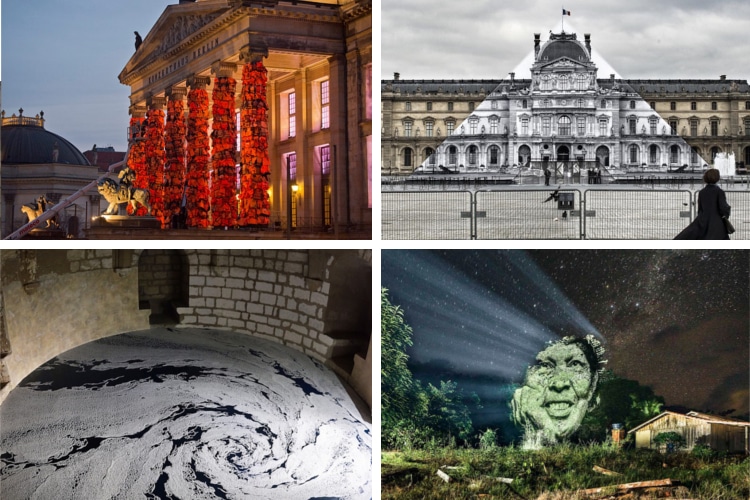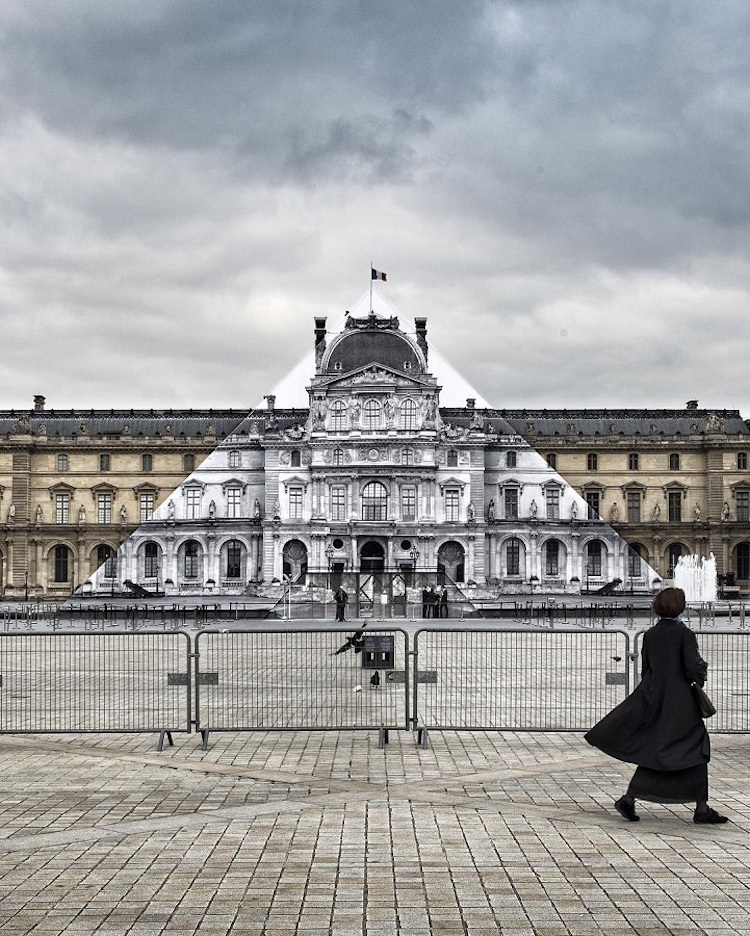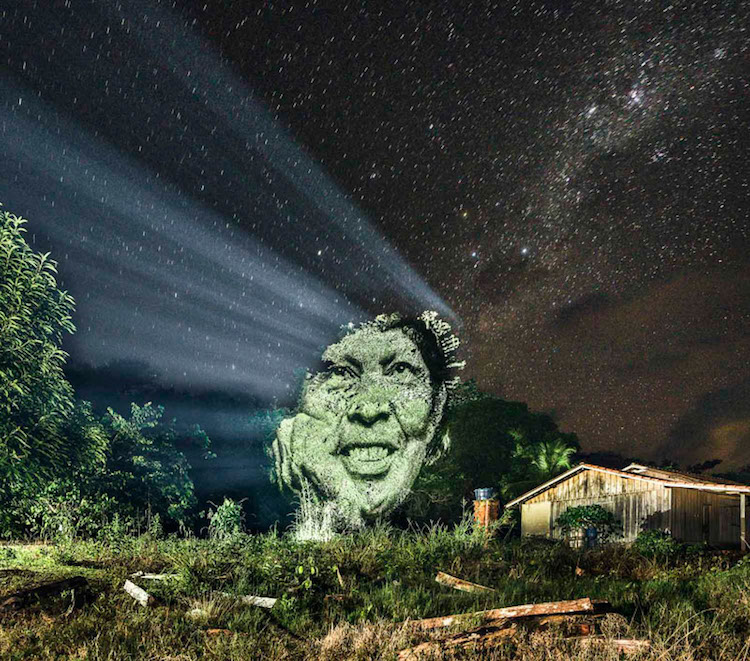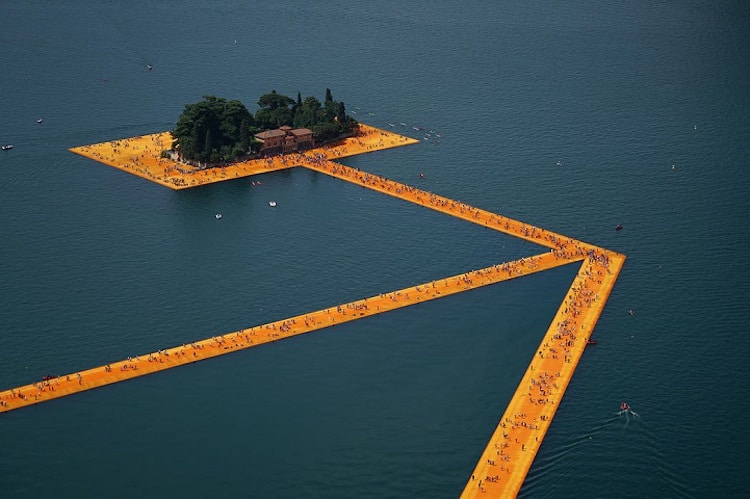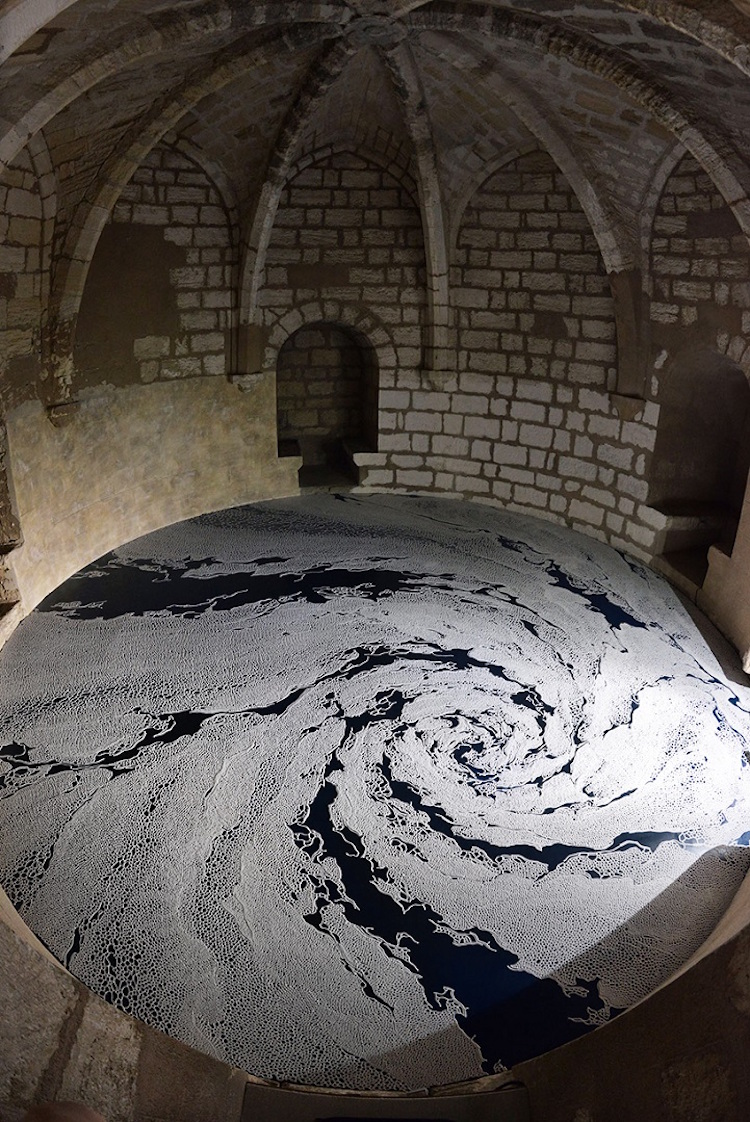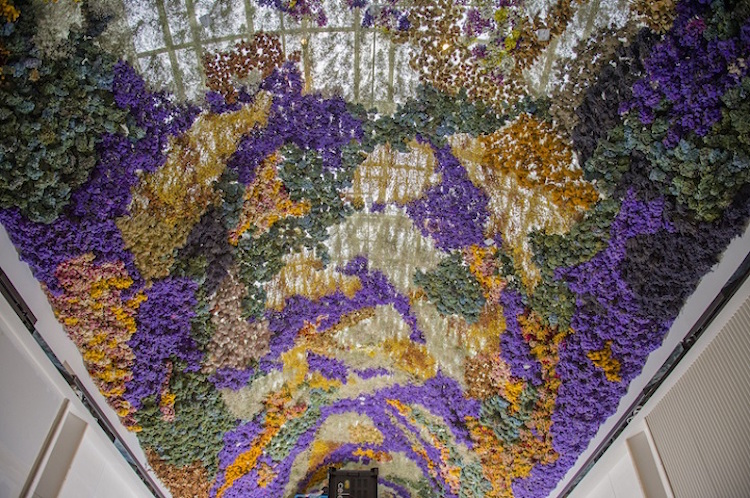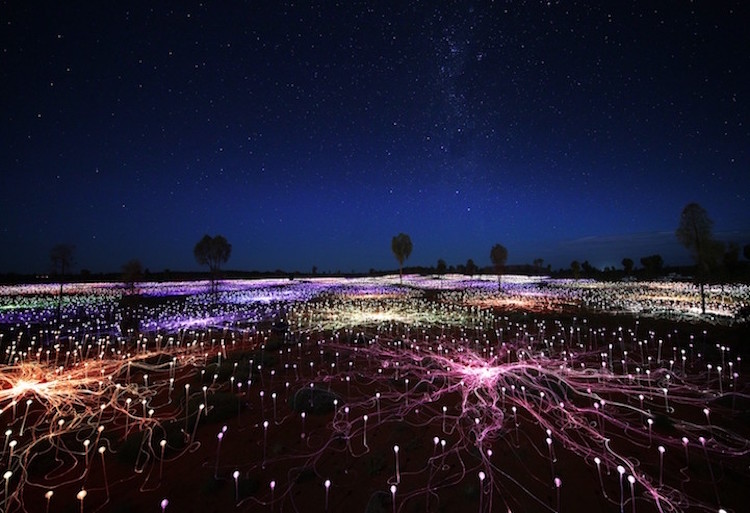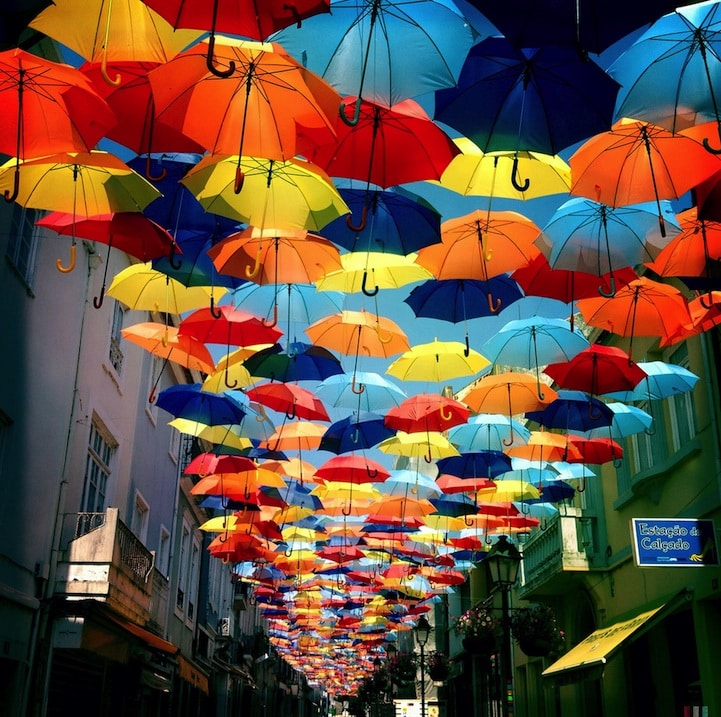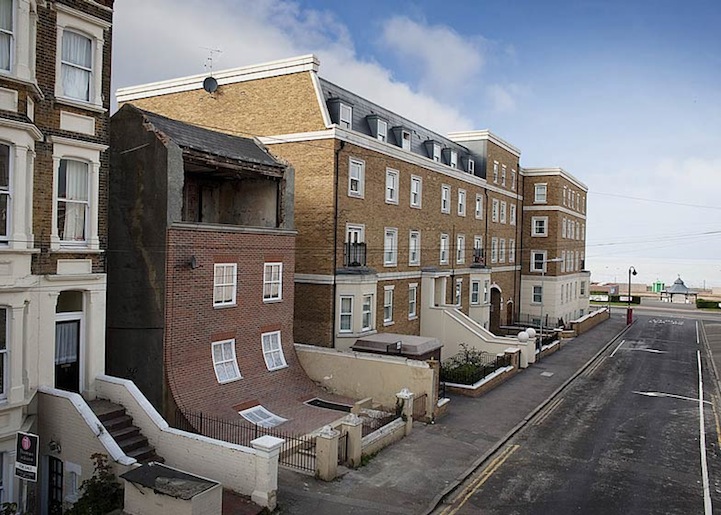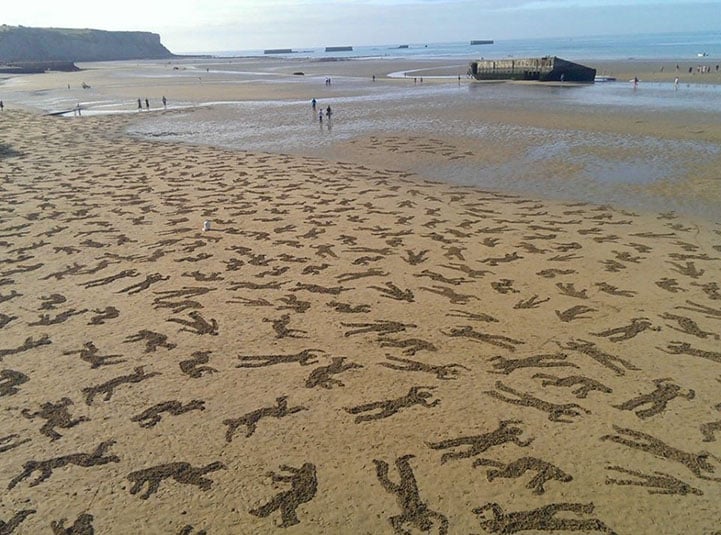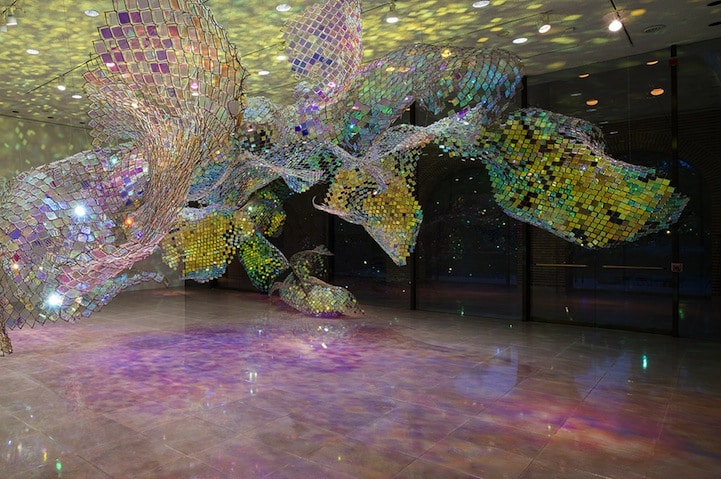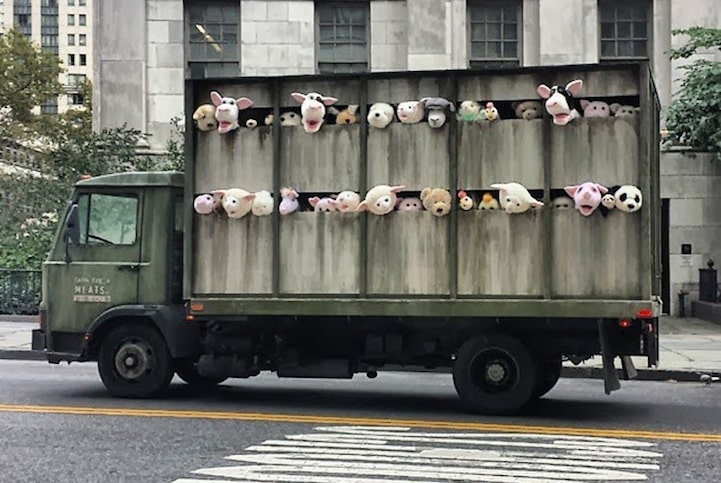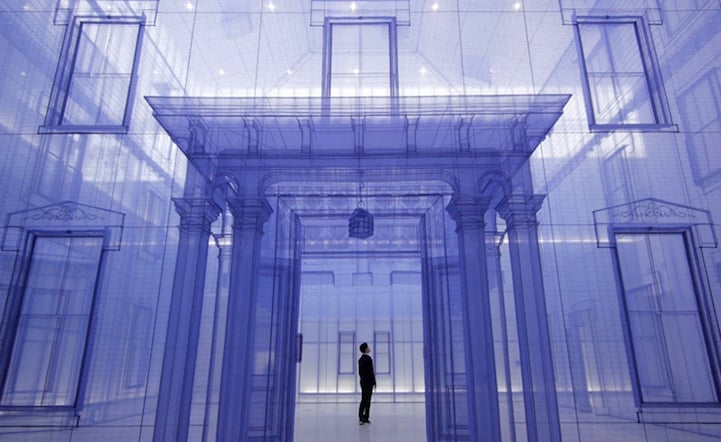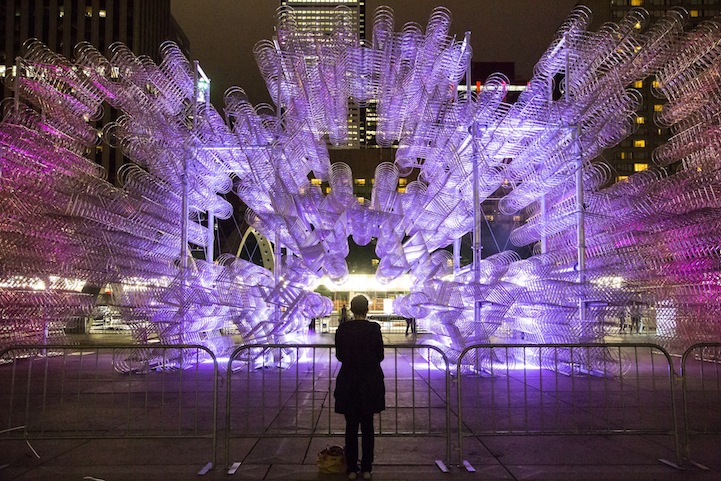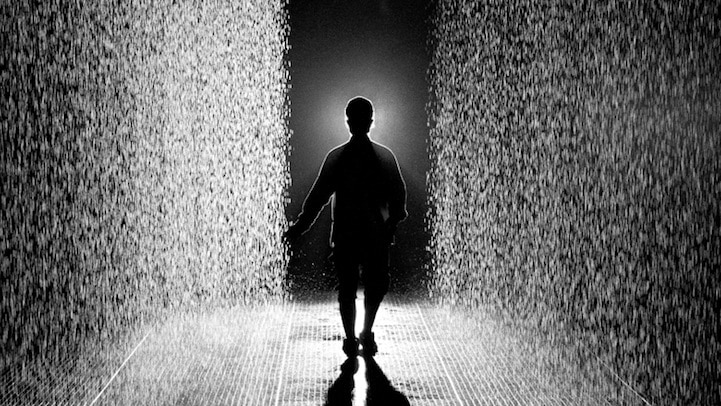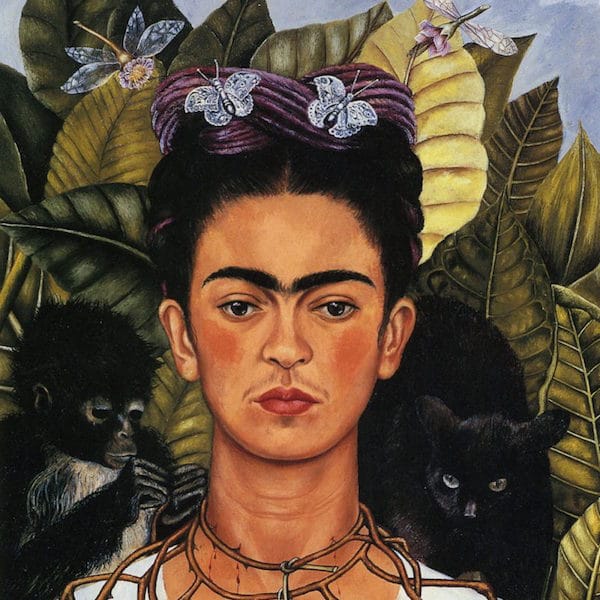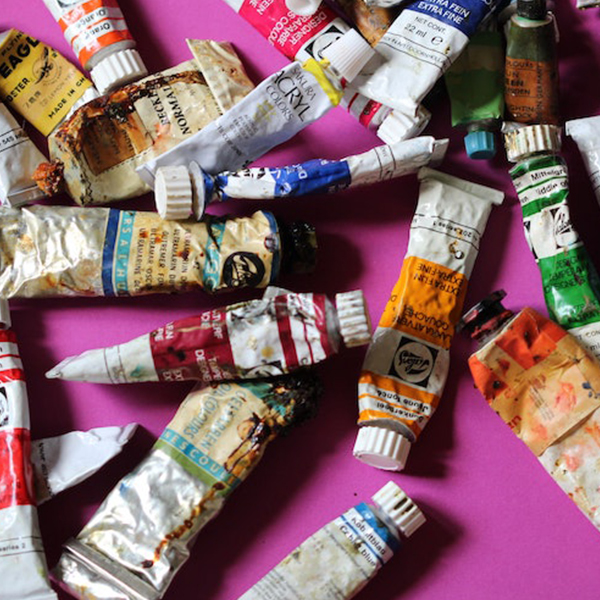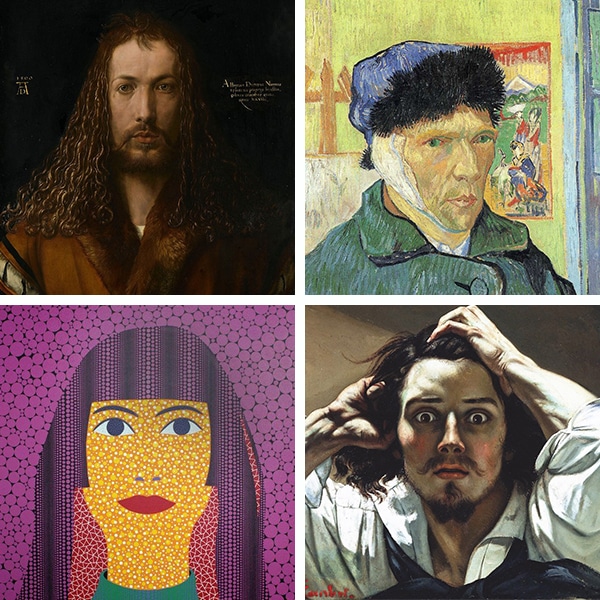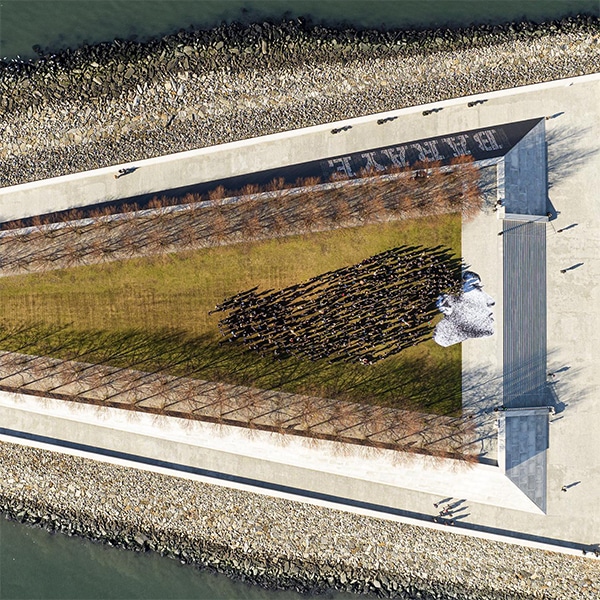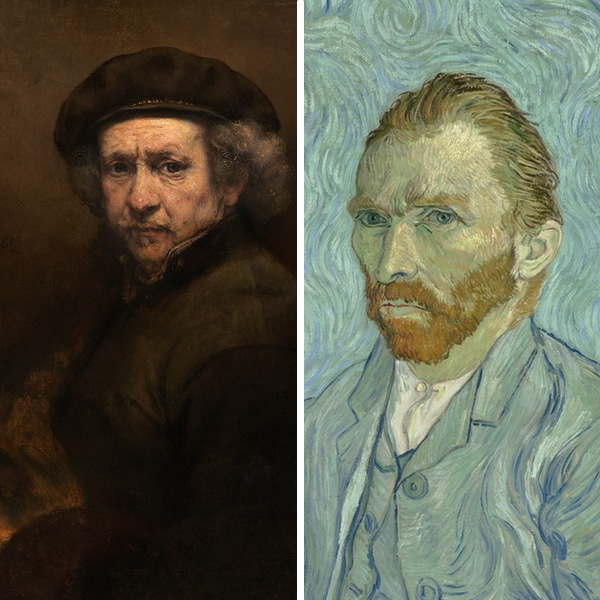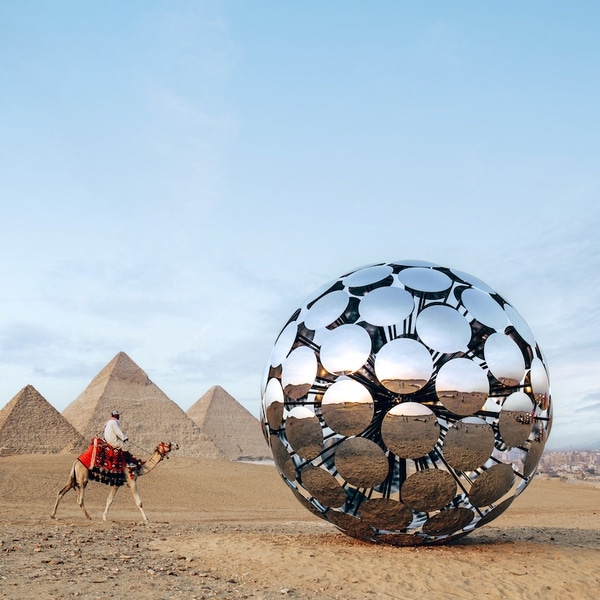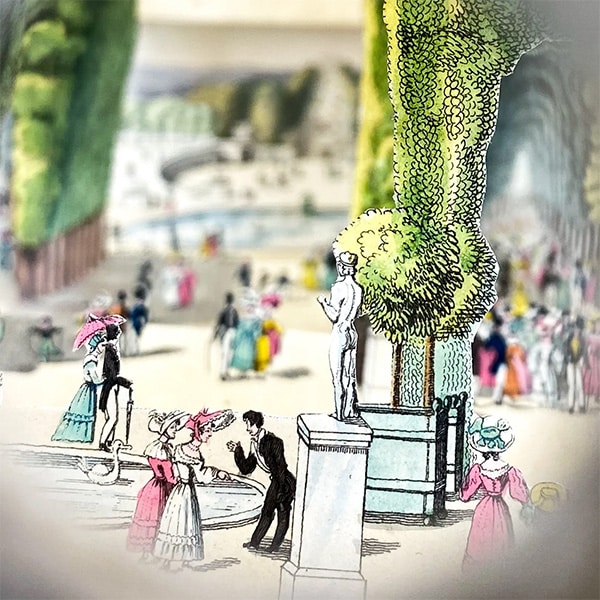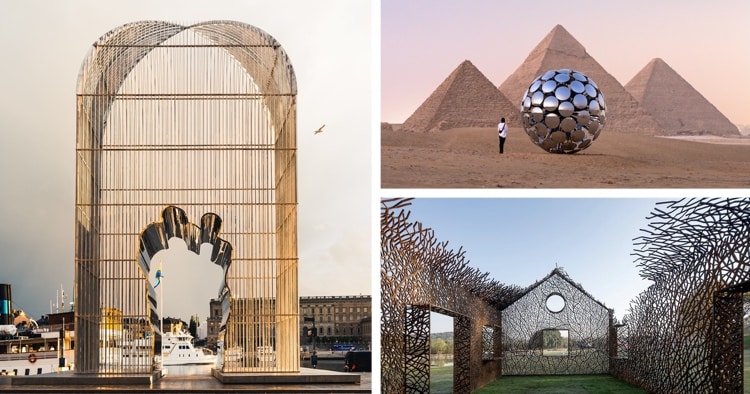
From the deserts of Egypt to a square in war-torn Ukraine, art installations spread their wings across the globe in 2022. After several years of sticking close to home, artists were free to move about and bring their artistry to different environments.
Our selection for the best art installations of 2022 includes familiar names like Ai Weiwei, JR, and Olafur Eliasson, as well as up-and-coming artists like Jun Ong and Mr. Doodle. But no matter the stage of their career, each artist on the list produced an installation that resonated deeply with its audience. No matter the meaning or intention behind the installation, each piece on this list was thoughtfully created with its environment in mind.
While in many instances it was possible to travel and see the installations in person, there are also several examples where artists created works that could only be appreciated through photography or video. In JR’s case, his temporary installation in a war-torn Ukraine was immortalized in a photograph that landed on the cover of TIME. For Mr. Doodle, his stop-motion video is the fruit of two years of creative labor. During that time he not only transformed his own home into an art piece, but also produced a video that has now been viewed nearly 20 million times.
Read on to see our list of the 10 best art installations of 2022 and then continue to learn more about the history of installation art, as well as our top 10 lists for every year since 2013.
Best Art Installations of 2022
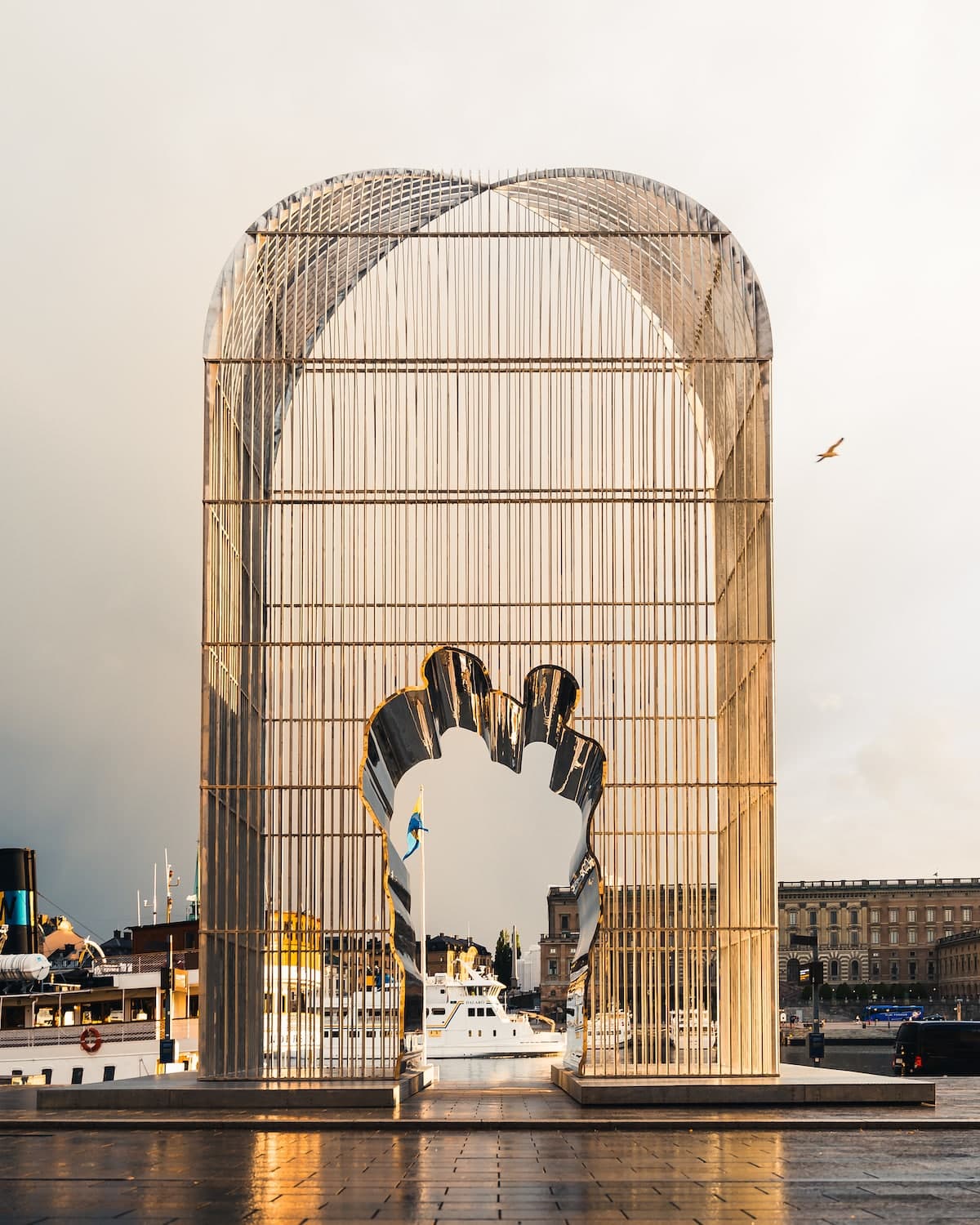
Arch by Ai Weiwei
Celebrated artist and activist Ai Weiwei has dedicated his career to creating thought-provoking work that asks viewers to confront complex political problems. His installation Arch in Stockholm was no exception. The 40-foot-tall form was made from solid steel bars and included a cutout that featured the outline of two figures. The figures in the center, surrounded by bars, embrace as a way to find comfort in the midst of harsh surroundings. The piece paid homage to refugees in Europe and around the world. It is also a reworking of an artwork originally placed in New York City’s Washington Square Park in 2017.
View this post on Instagram
TIME Cover by JR
French street artist JR traveled to Ukraine for a moving installation that was transformed into the cover of TIME. While in Lviv, JR gathered locals to unfurl a giant 148-foot-long portrait of Valeriia—a 5-year-old girl who was forced to flee to Poland due to the war. Her smiling portrait became a symbol of what Ukraine is fighting for, as well as a reminder of the millions who have been uprooted since Russia invaded the country in February 2022.
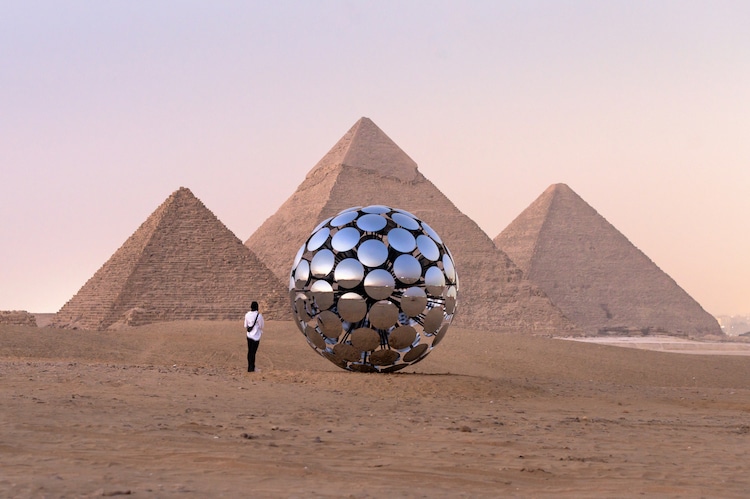
ORB by SpY
The Giza pyramids in Egypt are the dramatic backdrop for ORB, a glistening-mirrored installation by Spanish artist SpY. Influenced by the cultural heritage of the Ancient Egyptians, SpY created a sphere composed of polished-chrome circles. The anonymous artist studied the mathematics and geometry of the pyramids, as well as looked at symbols tied to the beliefs of the Ancient Egyptians during the ideation of ORB. The work was part of the Forever is Now II exhibition organized in collaboration with UNESCO and the Egyptian Ministry of Tourism and Antiquities.
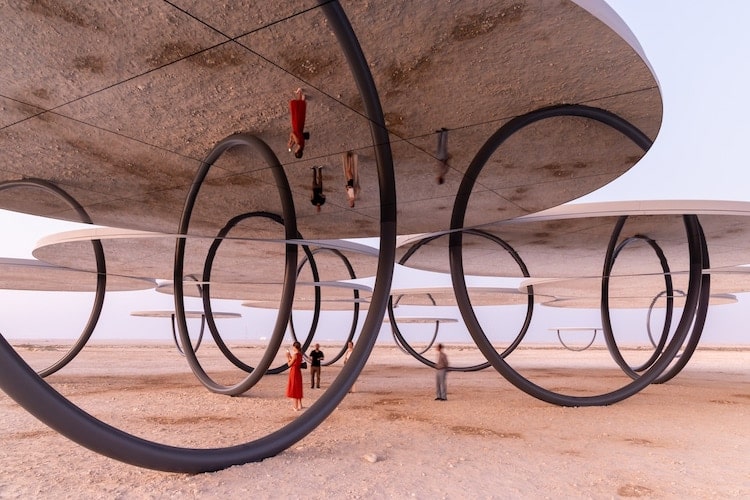
Shadows Travelling On the Sea of the Day by Olafur Eliasson
Artist Olafur Eliasson spent a decade developing Shadows Travelling on the Sea of the Day, his installation in the desert outside of Doha. The work features 20 mirrored circle shelters that are “an invitation to resync with the planet.” When moving within the installation, visitors see both themselves and the environment reflected back, which forces them to question their own place on Earth. The piece was part of a project by Qatar Museums to transform the country’s public space for the 2022 FIFA World Cup Qatar.
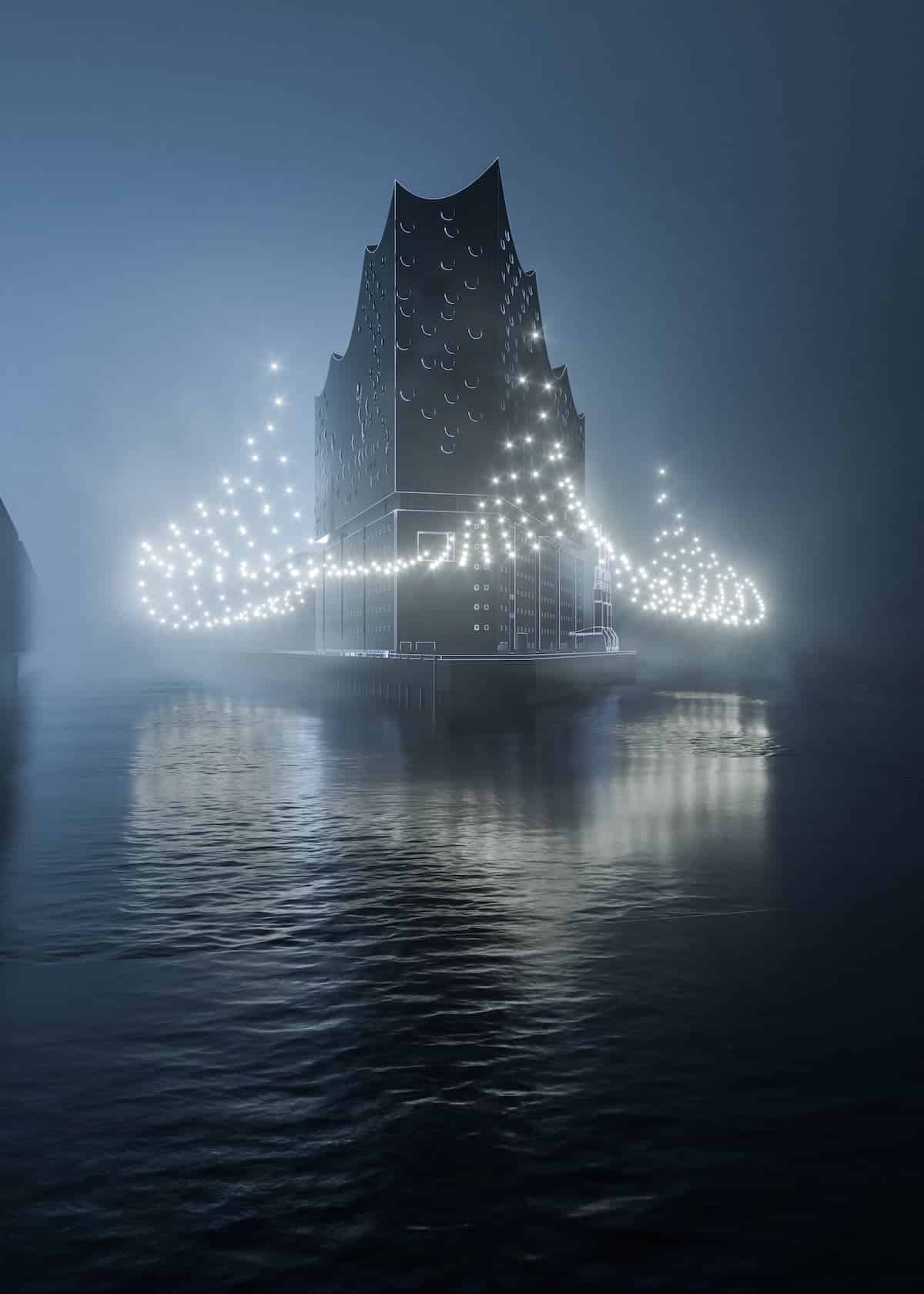
Breaking Waves by DRIFT
To celebrate the fifth anniversary of the iconic Elbphilharmonie Hamburg in Germany, DRIFT created an incredible light installation. Breaking Waves used hundreds of illuminated drones to create floating ripples of light around the Herzog & de Meuron-designed building. The drones were synchronized to the music played during the anniversary concert. In doing so, DRIFT accomplished its goal to bring the celebration to the public at large, allowing them to participate even from a distance.
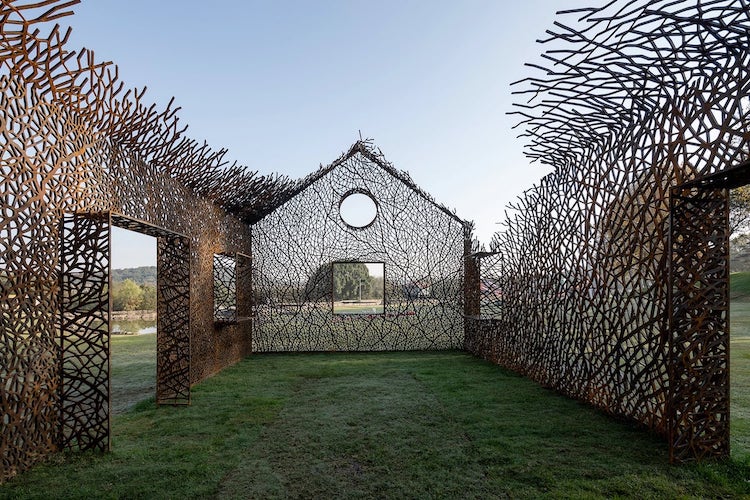
The Vanished House by Field Conforming Studio
Field Conforming Studio designed a space for memorializing and mourning with The Vanished House. Set within a cemetery in Wuhan, China, the installation used weathered metal as vines that twisted and crept up from the grass to create a partially formed house. “A symbol of hearth and home,” Field Conforming Studio wrote, “this house, as detached, leaves a space formed by the wrapping creepers. It is the remembrance of a vanished living space and thus of the people and things of the past.”
The Doodle House by Mr. Doodle
Sam Cox, better known as Mr. Doodle, set the internet on fire when he released a video of a project that took him two years. In the two-and-a-half-minute stop-motion video, he covers every inch of his home with his signature black and white doodles. In the end, his house becomes a giant installation, both inside and out.
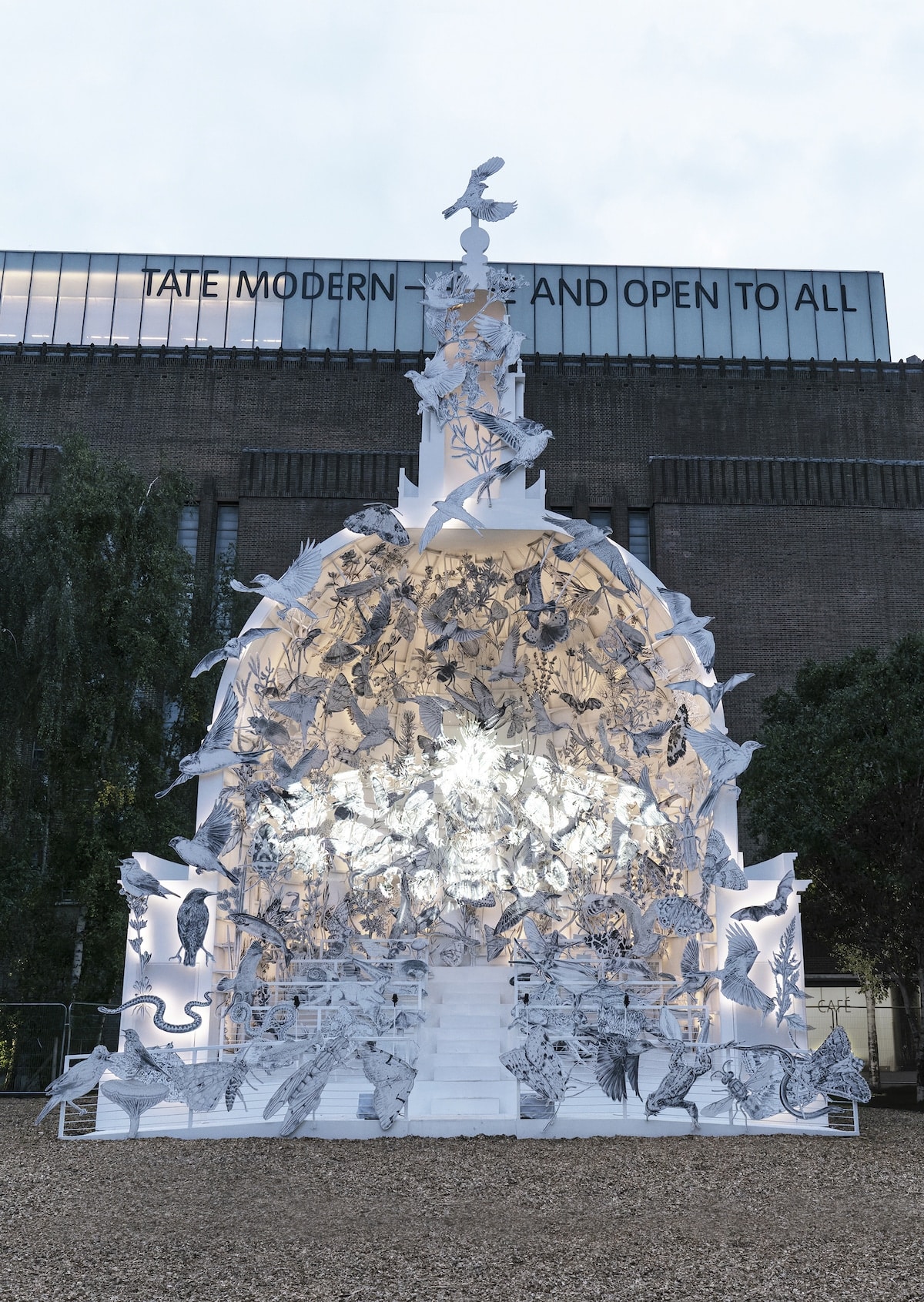
Come Home Again by Es Devlin
Artist Es Devlin drew 243 endangered species on London’s priority conservation list for an installation that asked the public to think about their place in nature. Nestled within an illuminated sculpture that mimics the dome of London’s St. Paul’s Cathedral, these drawings were a haunting reminder of the biodiversity that London risks losing.

Qaammat Pavillion by Konstantin Ikonomidis
With his Qaammat Pavillion, Swedish architect Konstantin Ikonomidis created a structure that perfectly harmonizes with nature. Nestled into the cultural landscape of Greenland, the transparent structure features a see-through glass shell inspired by Arctic light.
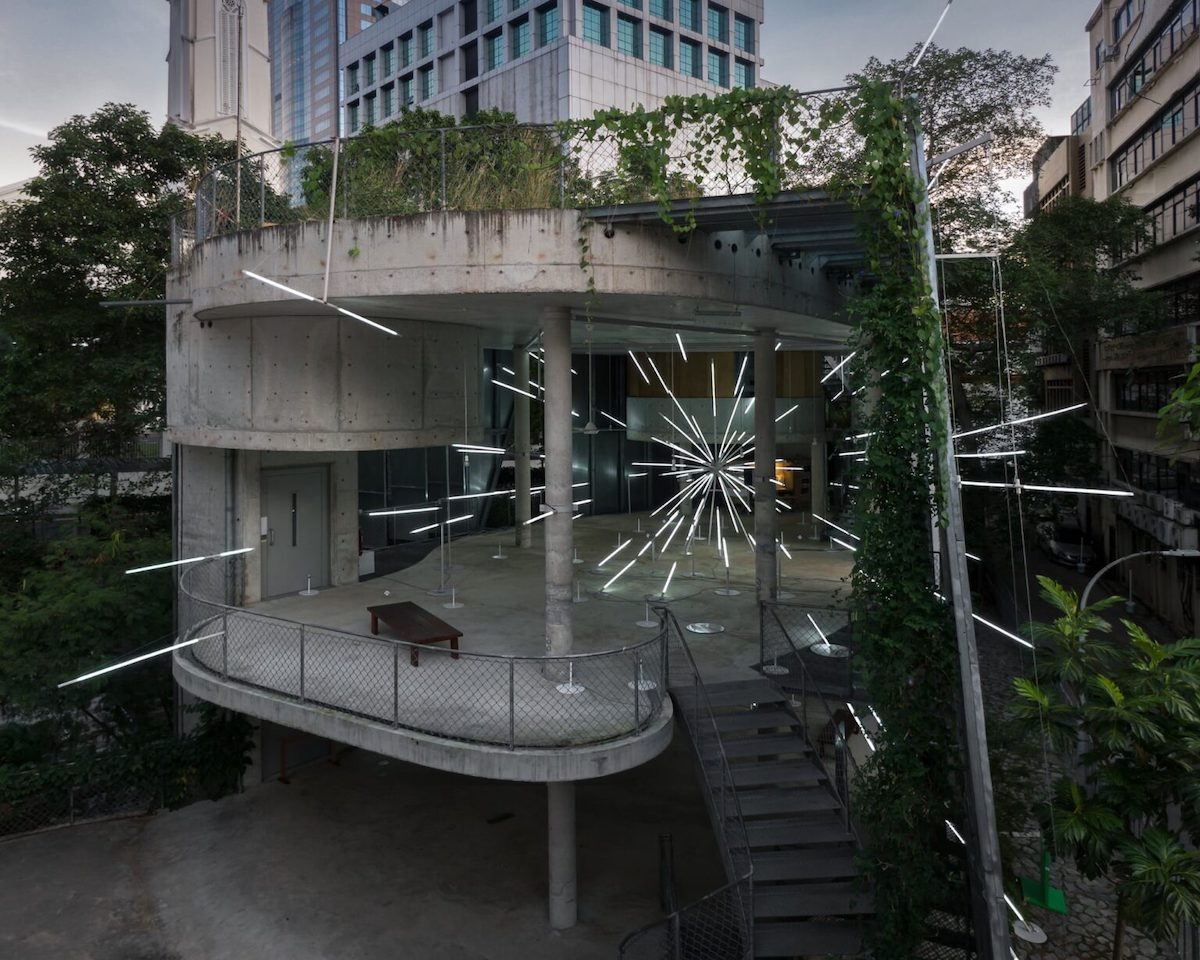
STAR/KL by Jun Ong
Malaysian artist Jun Ong used 111 LED beams to pierce a former warehouse in Kuala Lumpur with light. The result is STAR/KL, a starburst that is part of the artist’s concept to plant metaphorical “stars” in different places. One sees each one as an incubator for collaborations, experiences, and conversations.
Next: Best Art Installations of 2013–2021

Heartbeat by Charles Pétillon
Like most movements that make up modern and contemporary art, installation art exhibits an interest in innovating. Though similar to sculpture and related to a range of recent artistic genres, the immersive practice offers a unique way to experience art. In order to grasp the significance of such a movement, it is important to understand what makes it so special, from its distinctive qualities to its artistic influences.
Tied to a specific place, installations are grounded in their environment. And the three-dimensional artwork really lives and breathes outside of the artist's studio. Whether installed in a large gallery or museum or situated outdoors, they are created to engage with the public.
Here, we explore the avant-garde movement, paying particular attention to the ways in which it creatively engages audiences and manufactures new experiences.
What is Installation Art?
Installation art is a modern movement characterized by immersive, larger-than-life works of art. Usually, installation artists create these pieces for specific locations, enabling them to expertly transform any space into a customized, interactive environment.
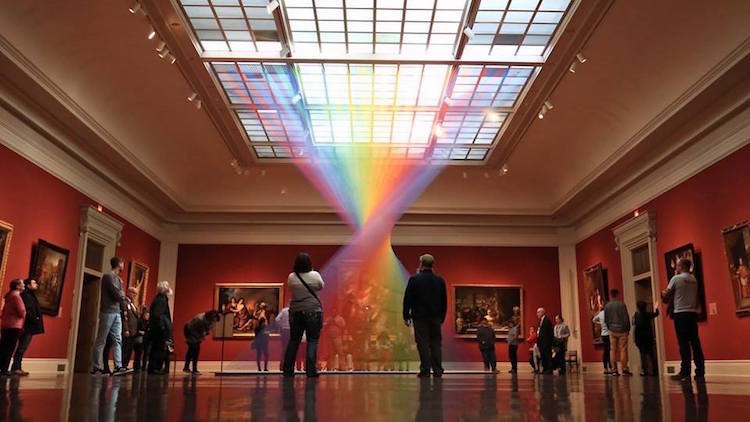
Plexus 35 by Gabriel Dawe
Characteristics
Immersive
A key attribute of installation art is its ability to physically interact with viewers. While all artistic mediums have the ability to engage individuals, most do not completely immerse them in interactive experiences.
In addition to facilitating dialogues between observers and works of art, this unique characteristic invites individuals to view art from new and different perspectives—literally!
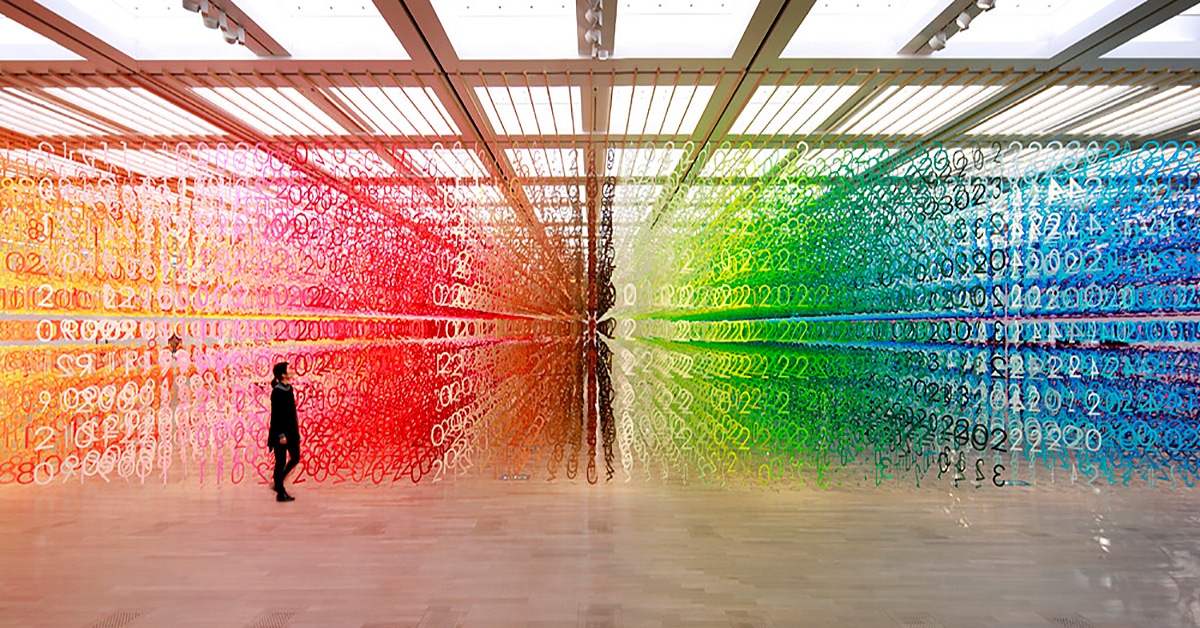
Forest of Numbers by Emmanuelle Moureaux
Large-Scale
Given their interactive nature, most works of installation art are large in scale. Their sizable statures enable viewers to become completely immersed in each larger-than-life environment. In many cases, it even allows them to sit, stand, or walk through it—a distinctive capability not commonly found in more traditional forms of art.
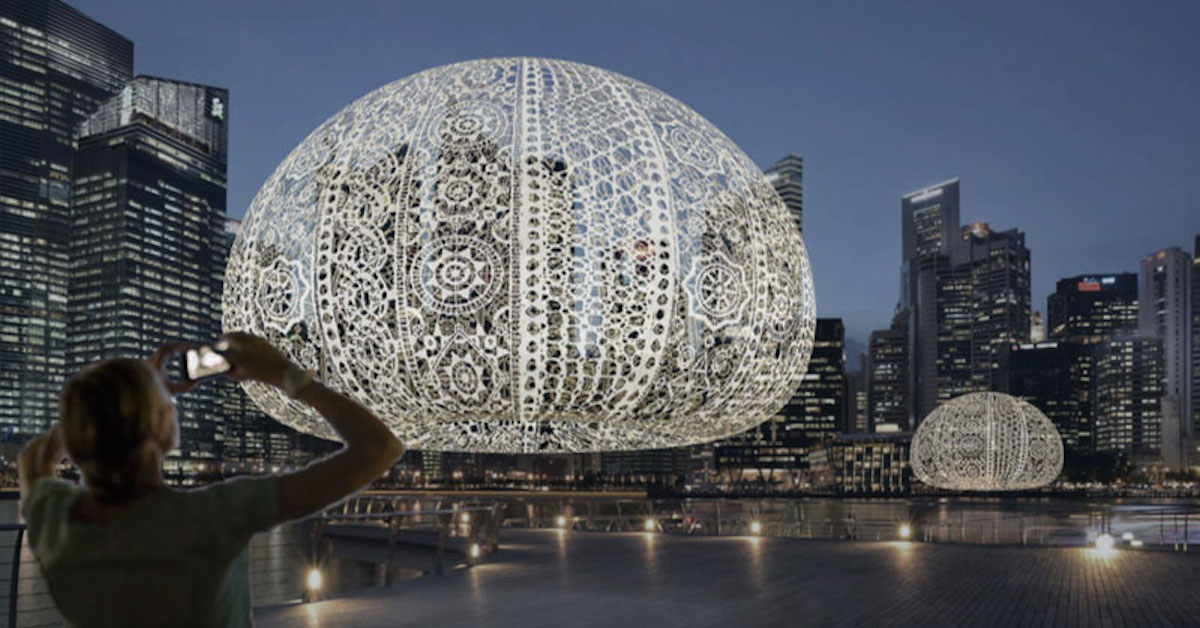
The Urchins by Choi+Shine Architects
Site-Specific
Unlike sculptures, paintings, and similar pieces, installations are usually planned with certain sites in mind, from rooms in galleries and museums to outdoor spaces. Given the strategic nature of their designs and the uniqueness of their surroundings, site-specific works of art ensure a one-of-a-kind aesthetic and experience.
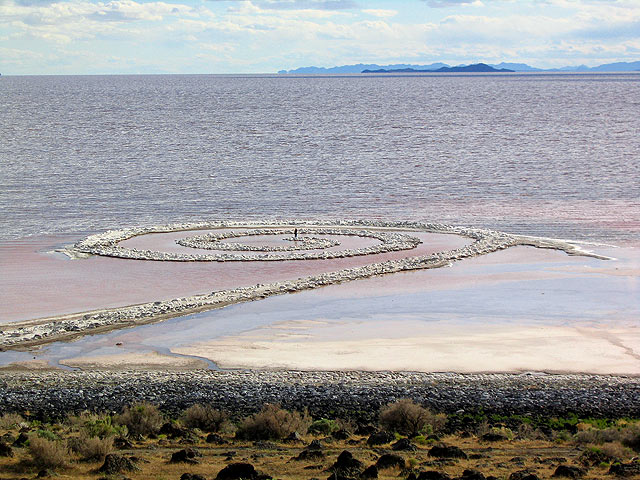
Spiral Jetty by Robert Smithson 1938-1973 (Transferred from en.wikipedia to Commons.) [Public domain or CC BY-SA 2.5], via Wikimedia Commons
Influences
Like many modern and contemporary genres, the installation art form is rooted in several different movements—namely, Dada, conceptualism, and performance art.
Dada
Like Dada, an avant-garde movement that emerged in the early 20th century, installations often showcase an experimental approach to art. Specifically, installation art's incorporation of mixed media and emphasis on three-dimensionality are undoubtedly inspired by two Dada staples: ready-mades and assemblages.
Conceptualism
Inspired by the Dadaists, Conceptual artists believe that the idea behind a work of art takes precedence over its aesthetic. This sentiment is also present in installation art, with well-known contemporary artists like Ai Wei Wei and Damien Hirst using their celebrated installations as a means to relay messages to viewers. “As a person, I was born to give out my opinions,” Ai Wei Wei explains. “By giving out my opinions, I realize who I am.”
Performance Art
While performance art—a practice performed before an audience—may seem dissimilar to installation, a form of fine art, the two movements are linked by a key characteristic: a creative and conceptual use of space. In both cases, artists find innovative and inventive ways to reinterpret and reimagine everyday environments.
Now that we know a bit more about the history of installation art, it's time to dive in and see the best art installations around the world since 2013.
Best Art Installations of 2021
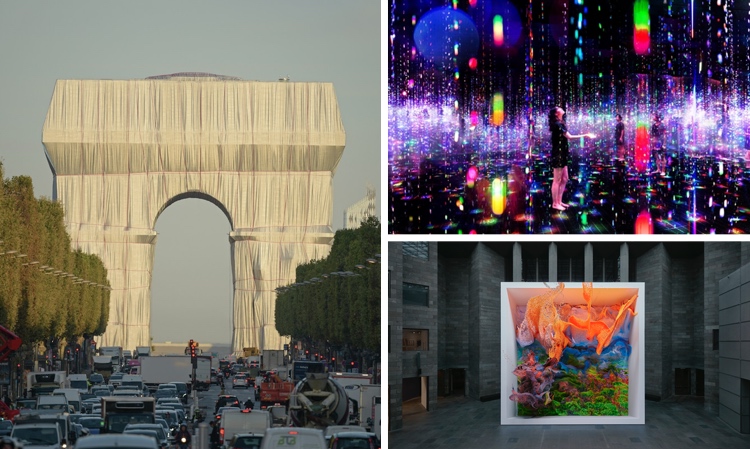
Coming off of a year unlike any other in recent history, artists were ready to get back to work as the world started opening up again. While social justice issues and the pandemic still sparked moving works of art, plenty of artists also moved beyond those themes to explore new territory. The result is 10 art installations that are not only the best of 2021, but also varied in their approach.
Whether we are looking at Refik Anadol’s use of AI or Daniel Popper’s nature-inspired sculpture, each installation has something important to say. 2021 was also the culmination of Christo and Jeanne-Claude’s long-awaited plans to wrap Paris’ Arc de Triomphe in fabric. Initially scheduled for 2020, but delayed by the pandemic, this thrilling installation also turned into a posthumous tribute to Christo.
Loss and hope were other strong themes in this year’s group of installations. Some artists, like Motoi Yamamoto, produced work influenced by their own personal loss. Other installations, like the life-size elephant sculpture traveling the globe for the CoExistence project, focused on global loss.
No matter what the message, what these art installations have in common is their ability to create impact. Each, in its own unique way, sends a message to viewers and stirs emotion in an undeniable way. Let’s take a closer look at these 10 art installations to see what makes them the best of 2021.
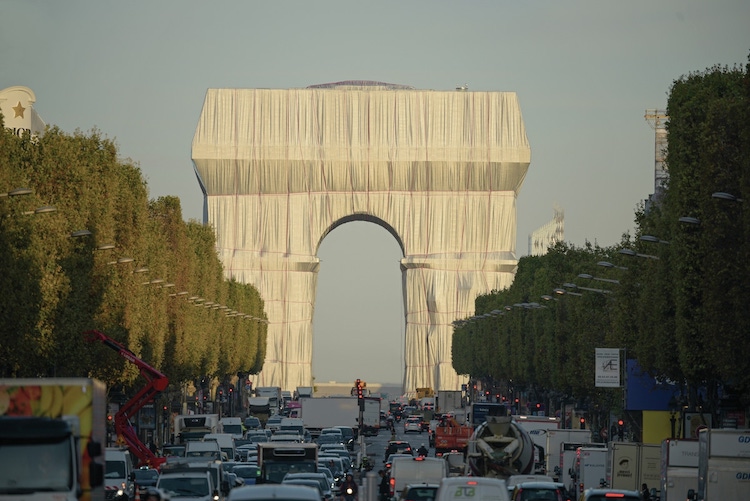
Arc de Triomphe Wrapped by Christo and Jeanne-Claude
It was a dream of the artistic duo to wrap Paris’ iconic Arc de Triomphe in their signature fabric. Though due to delays, their vision was only realized after they had both passed, surely they are smiling down upon this installation.
Swathed in fabric held together by red ropes, the installation is the culmination of more than five years of work. For a little over two weeks, the public could enjoy the shimmering building and get close enough to touch the artwork, just as Christo and Jeanne-Claude would have wanted.
View this post on Instagram
In America. How Could This Happen… by Suzanne Brennan Firstenberg
Certainly one of the year’s most moving installations took place on the National Mall. In America. How Could This Happen… was created by Suzanne Brennan Firstenberg to commemorate what has been lost in the COVID-19 pandemic. All told, over 670,000 white flags dotted the area, each representing an American life lost.
This installation quickly became more than a piece of art. It was a place for people to mourn what has been lost and to pay their respects. In doing so, Firstenberg gave people an important outlet for their emotions after this pivotal time in history.
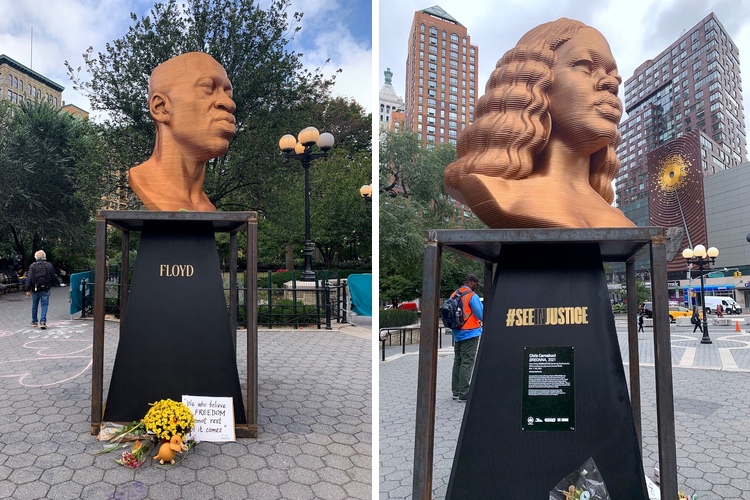
Photo: Pinar Noorata/My Modern Met
SEEINJUSTICE by Chris Carnabuci in collaboration with Confront Art
Sculptor Chris Carnabuci transformed his artistic response to the social climate of 2020 into something big by working with Confront Art on large-scale busts of George Floyd, Breonna Taylor, and John Lewis. Made from 200 layers of thinly sliced African Mahogany wood and coated in shimmering bronze, they were installed in New York City's Union Square.
By working with Floyd's brother Terrance, the collective group wishes to marry “monuments with a movement.” The plan is to continue the exhibition of these sculptures across the country and then auction them off, with proceeds to go to a charity that represents each individual.
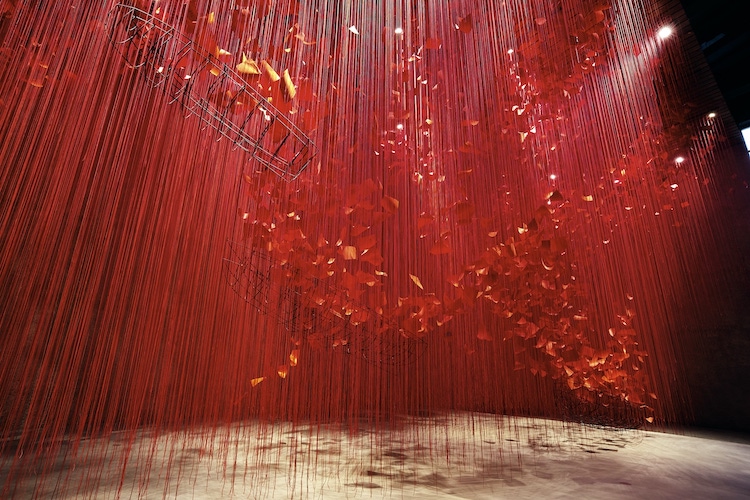
I Hope by Chiharu Shiota
After a long period of isolation, Japanese artist Chiharu Shiota wished to instill hope in others. To do so, she collected 10,000 letters from people around the globe and strung them together with scarlet thread. Installed in a former church-turned-exhibition-space in Berlin, the suspended threads created a delicate web for these letters exploring peoples’ hopes for the future.
While the installation couldn’t be open to the public for the entire duration, Shiota invited musicians and dancers to create interactive performances with the piece, which were then live-streamed. This restriction only served to show the resilience of artists, who are forging ahead of their work in a new age when crowds are often off limits.
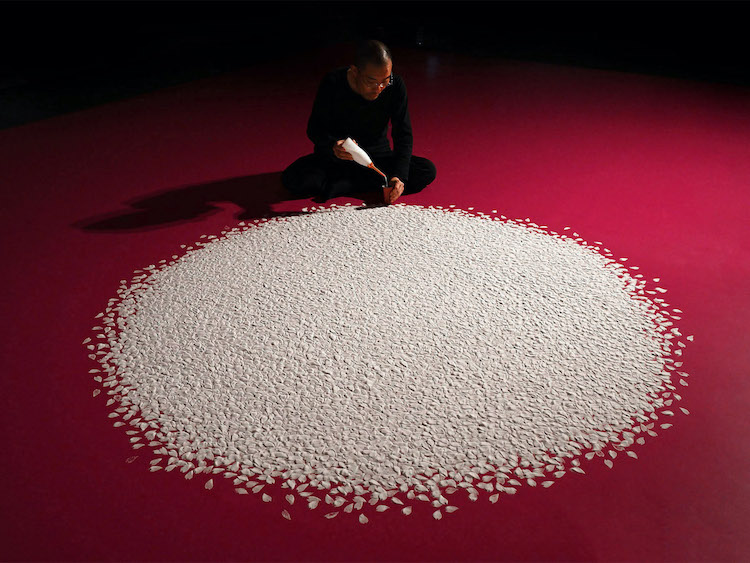
Photo: © Motoi Yamamoto 2021
Salt Cherry Blossoms by Motoi Yamamoto
For his solo exhibition at the Setouchi City Museum of Art, Japanese artist Motoi Yamamoto created an intimate reflection on memory, reminiscing, and moving toward the future. Over 100,000 fallen cherry blossom petals were lovingly created from salt—a medium Yamamoto often works with.
This choice is both aesthetic—Yamamoto appreciates its whiteness—and symbolic. In Japan, salt has been associated with cleansing since ancient times. The fragility of the work is connected to its meaning—life is ephemeral and can change at a moment's notice. A quiet, reflective installation, Yamamoto has created a space to contemplate life and its meaning.
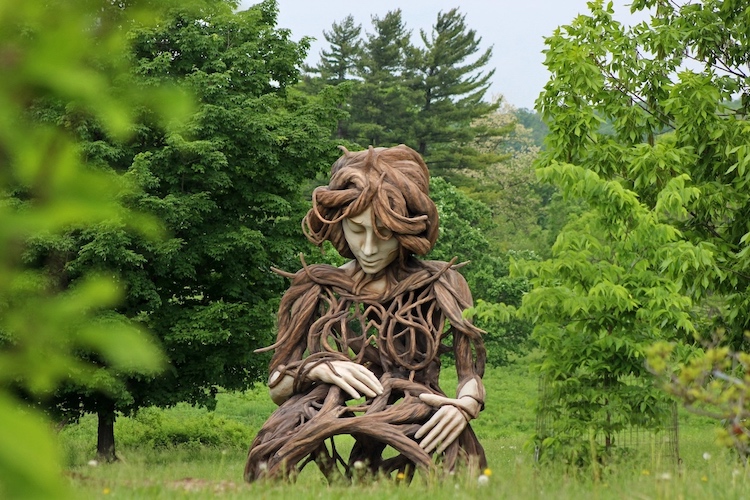
Human+Nature by Daniel Popper
When artist Daniel Popper installed his five monumental sculptures at The Morton Arboretum for his Human+Nature exhibition, he completely transformed the 1,7000-acre environment. His nature-inspired work helped root visitors in the arboretum’s mission to connect with trees.
By using natural motifs, his oversized figures weave a tale of just how interconnected nature and humans are. Particularly striking is UMI, a sculpture of a maternal figure gently cradling her bump. As she looks down, her body formed from seemingly intertwined branches, she appears to be contemplating her impending motherhood.
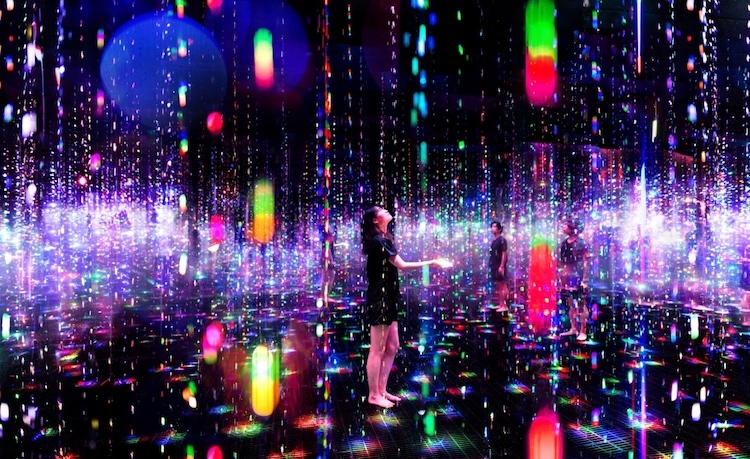
TikTok teamLab Reconnect by teamLab
International art collective teamLab makes frequent appearances on this annual list, and 2021 is no exception. Known for their incredible, immersive experience, this time they’ve pushed things further with an installation created in partnership with TikTok. TikTok teamLab Reconnect took the art-viewing experience to a new level by incorporating a sauna ritual.
On display in Tokyo, the installation takes advantage of the deep sauna culture in Japan. Visitors were invited go into a “sauna trance” by moving through a sauna and cold bathing area before resting in one of five immersive environments. They were then encouraged to repeat the cycle in order to experience a new piece of art.
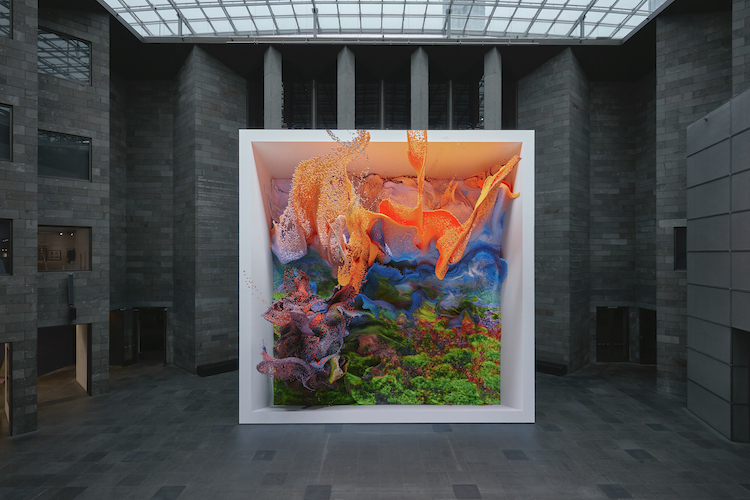
Quantum Memories by Refik Anadol
Digital artist Refik Anadol uses cutting-edge technology to create incredible installations. In early 2021, he created a piece for the NGV Triennial using AI. In fact, over 200 million images of nature were used to put together Quantum Memories.
The results were mesmerizing videos set into an enormous frame. The three-dimensional qualities of the imagery only added to the dynamic installation. As he told My Modern Met, by working in this way “AI is letting me paint with a thinking brush.”
Bonus: Learn more about Refik Anadol's work in his interview with the My Modern Met Top Artist Podcast.
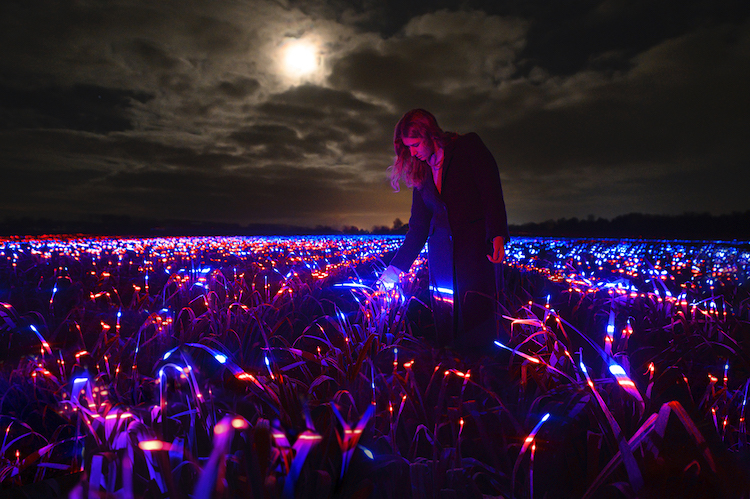
Grow by Daan Roosegaarde
Dutch designer Daan Roosegaarde is known for his installations that help us imagine a better world. His Grow installation is no exception. In this piece, he transformed a 20,000-square-meter (approximately 215,278-square feet) leek field into a piece of art thanks to red and blue LED lights.
These lights not only give the field a futuristic look, but they also encourage plant growth. Roosegaarde incorporated “light recipes,” using different light frequencies that activate the plants’ metabolism and increase their resistance to pests. The work is part of a bigger plan to raise awareness about using connectivity with nature.
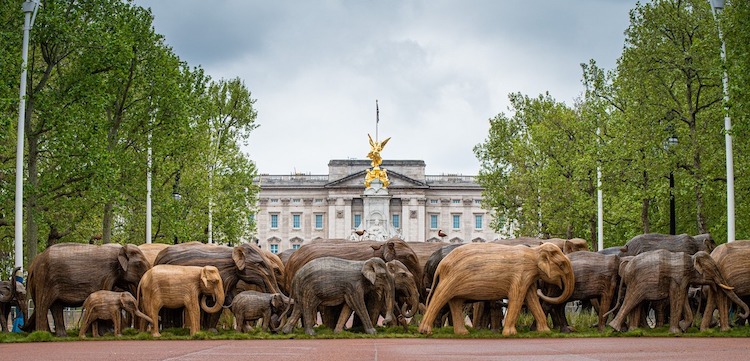
CoExistence by Elephant Family and The Real Elephant Collective
When non-profits Elephant Family and The Real Elephant Collective got together to raise awareness about the plight of elephants, they went big. This meant commissioning 100 life-size sculptures of lantana elephants that would travel the UK to raise awareness of how humans are negatively affecting these gentle giants.
The sculptures were created in India. In fact, they were hand-crafted by Indigenous communities and then made their long journey to the UK. Once there, they were put on display in several places before splashing down in London for a prominent exhibition in the Royal Parks and Berkley Square. All funds raised were then given back to grassroots projects in India that are working to allow people and wildlife to coexist more peacefully.
Best Art Installations of 2020

To say that 2020 was a year like no other is an understatement. World events, from the COVID-19 pandemic to the Black Lives Matter protests, shaped the way we lived. And, as a consequence, they also shaped the way we saw and consumed art. With many museums and galleries closed for extended periods, artists were more resourceful than ever in getting their messages across. This was particularly true of installation artists.
Many artists chose to focus their practice around what was happening in the world, and this often meant striking out on their own. From Dustin Klein‘s spontaneous light projections on the Robert E. Lee Monument to Jammie Holmes‘ powerful airplane banners with the last words of George Floyd, artists were not afraid to use their art to highlight social issues. Some, like flower designer Lewis Miller, even used their skills to give thanks to the brave healthcare workers putting their lives on the line during the pandemic.
And while much art was centered around world events, there were also other incredible art installations that managed to come to life, giving people a break from the divisive and depressing realities of the world. From interactive sculptures in the desert to underwater sculptures in the Great Barrier Reef, these installations reflect the incredible creativity of today's contemporary artists.
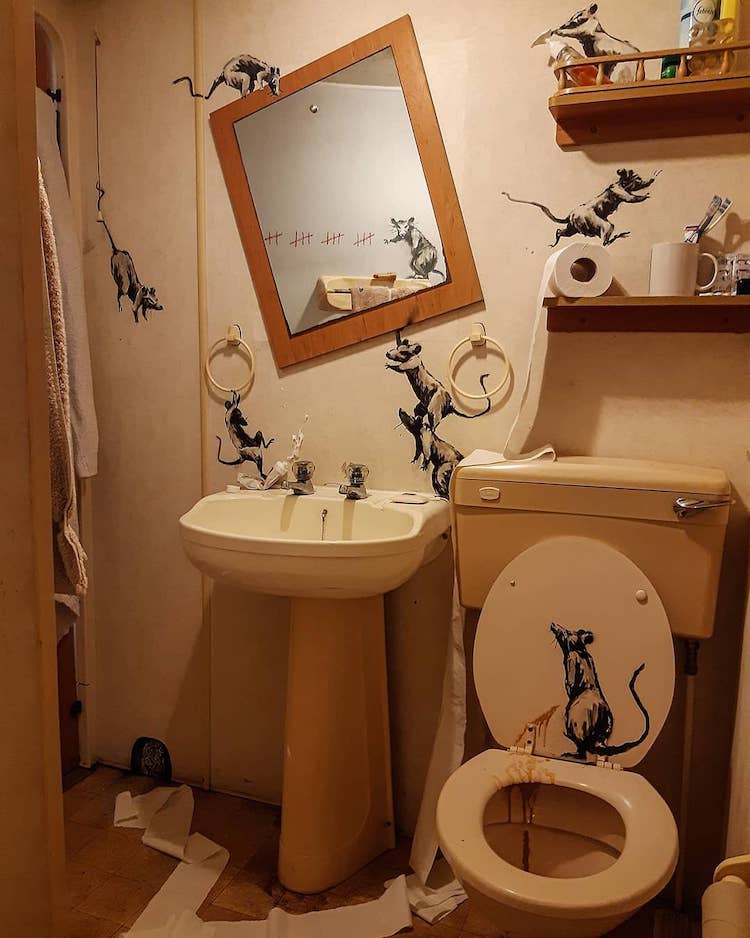
Photo: Banksy
My wife hates it when I work from home by Banksy
Staying at home in lockdown didn't make legendary street artist Banksy any less productive. He managed to find a space right in his own home to create an installation that exemplified how the whole world was going a little stir crazy. In this piece, which he captioned “My wife hates it when I work from home,” his rats run amok and wreak havoc in the bathroom.
From marking off the days in quarantine to using a roll of toilet paper to get a little exercise, these rats were all of us. And in posting this, Banksy once again showed how he's able to use humor and irony to get through a tough situation. This wouldn't be Banksy's only artistic contribution related to COVID-19. He also painted artwork for a local hospital and his rats took over a subway car with a warning to wear your masks and sanitize your hands.
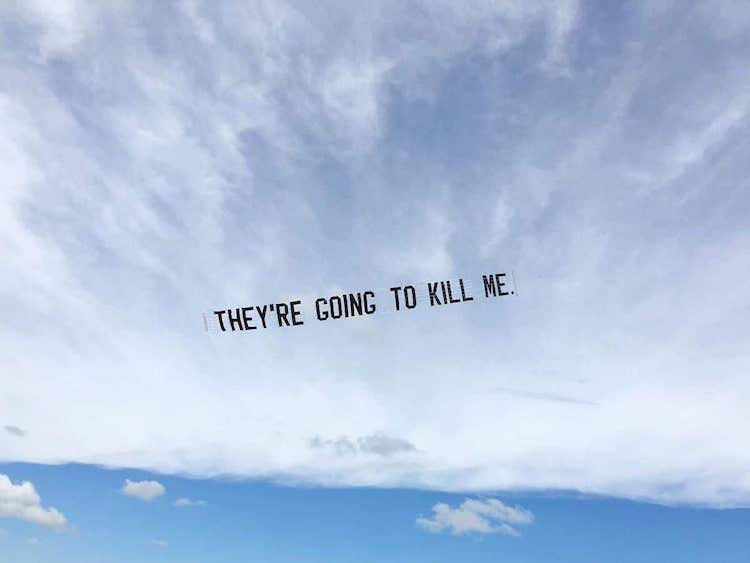
Photo: courtesy of Jammie Holmes and Library Street Collective
George Floyd Banners by Jammie Holmes
The senseless murder of George Floyd at the hands of Minneapolis police officers sparked outrage across the globe. Many artists used their craft to ensure that what happened to Floyd would not be forgotten, including Jammie Holmes. The artist organized airplanes to fly across five major U.S. cities carrying banners with Floyd's last words. The results are an in your face, undeniable look at the pain one man suffered that had rippling effects felt by millions. In reflecting his words to the public, Holmes forced us to think about what we can do to ensure this does not keep happening.
“I hope that people will be reminded of the power we can have to be heard and that coming together behind a unified message is key for real change,” Holmes said. “Like countless silenced and fearful young Black men, I have been the victim of police misconduct on a number of occasions in my life. Our mothers are burying us way too early. My fiancée shouldn’t worry every time I’m headed out of the house on my own. Yes, I carry a pistol, Mr. Officer. I carry it to protect myself from you by any means necessary. At some point, you will realize you can’t kill us all.”
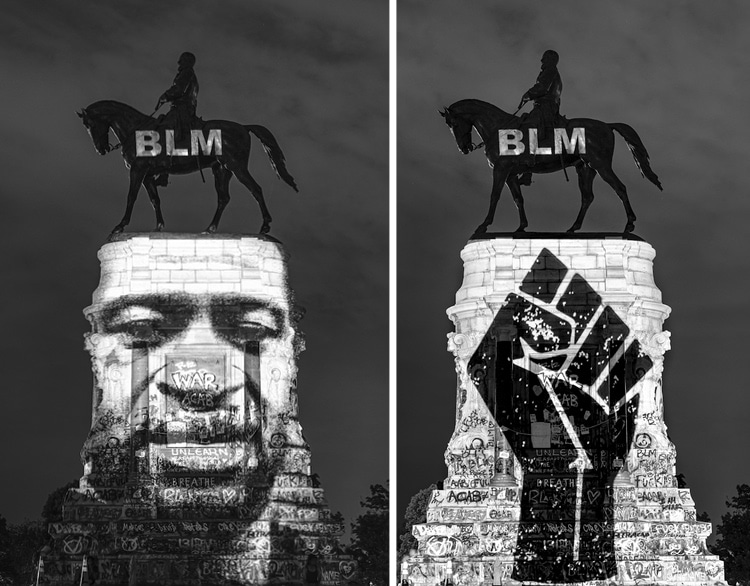
Photos: courtesy of Dustin Klein
Reclaiming the Monument by Dustin Klein
In the wake of George Floyd and Breonna Taylor's deaths, widespread protests in support of the Black Lives Matter movement happened across America. And in many cities, old Confederate monuments were forcibly removed or ordered taken down by the legislature. In Richmond, Virginia the last remaining of these was the Robert E. Lee Monument. So while the city decided what measures to take, light projection artist Dustin Klein took matters into his own hands.
For several months, Klein projected images of Black victims of police violence on the face of the monument as a way to transform the meaning of the statue. As the faces of these victims took center stage, the public was allowed to use the space to mourn and gather their thoughts. Klein then extended the project to also include the faces of important Black citizens throughout history—such as Frederick Douglass and Harriet Tubman—as a way to acknowledge the great contributions they've made to our country. Klein's project is a reminder that the best art can often come spontaneously from matters that move us.
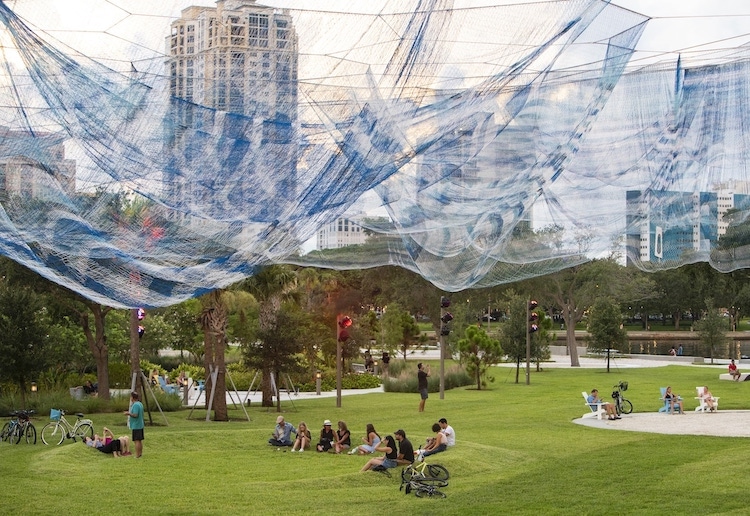
Photo: Brian Adams
Bending Arc by Janet Echelman
Artist Janet Echelman is known for her large-scale installations using twine. Her work in St. Petersburg, Florida is no exception. Measuring 72 feet tall and spanning 424 feet, Bending Arc is a focal point of the new Pier Park. Flowing and billowing in the wind, the installation is even more magical at night when it's lit up.
While the visual of the installation is impressive on its own, the work took on new meaning for Echelman when she discovered that it is located in an area that was important during the Civil Rights Movement. People gathered here in peaceful protest against the segregation of local municipal pools, which continued locally even after it was deemed unconstitutional. Upon learning this, Echelman decided on the title Bending Arc in a nod to a quote by Dr. Martin Luther King Jr.—”the arc of the moral universe is long, but it bends toward justice.”
View this post on Instagram
Flower Flash by Lewis Miller Design
Throughout the COVID-19 pandemic, members of the public have been showing their appreciation for front-line healthcare workers. Floral designer Lewis Miller had his own unique way of giving thanks by placing his Flower Flash installations in strategic locations across New York. One stop included New York-Presbyterian Hospital, where roses, lilies, and cherry blossoms were placed in an ornate arrangement.
Though Lewis' team was eventually asked to remove the flowers by hospital security, they made the most of it by handing out the flowers to the nurses, doctors, and healthcare workers who passed by. The positive reaction they had shows that even the most simple gestures can be the most powerful.
There were other installations that don't focus on the pandemic or Black Lives Matter, but they certainly highlight the creativity on display in 2020.
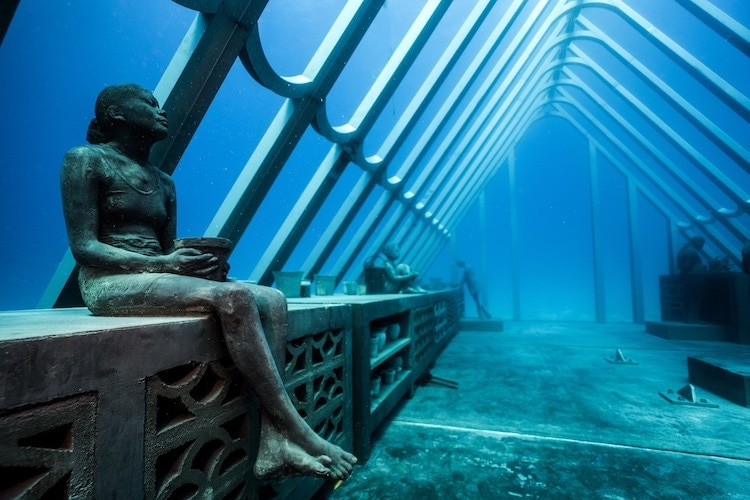
Photo: courtesy of Jason deCaires Taylor
Coral Greenhouse by Jason deCaires Taylor
Sculptor Jason deCaires Taylor never disappoints with his underwater sculptures, and his latest installation in Australia's Great Barrier Reef is no exception. After years of planning and installation, Taylor didn't let the pandemic get in his way—he was able to open this new underwater park on schedule. Working with the local community, Taylor conceived the Coral Greenhouse. In this installation, the youth are in charge of running a laboratory to investigate the ocean. And as always, the setup makes a wonderful artificial reef for marine life.
“One of the overriding objectives was that we wanted young people to be inspired by marine science and fascinated by it,” Taylor told My Modern Met. “And want to have an active interest in the health of the reef and to be able to explore it in a fun and dynamic way. One of the big objectives was to create this space encompassing many areas, to be not only a space for art and culture but only about marine science and to use it as a portal or access point to explore the Great Barrier Reef.”
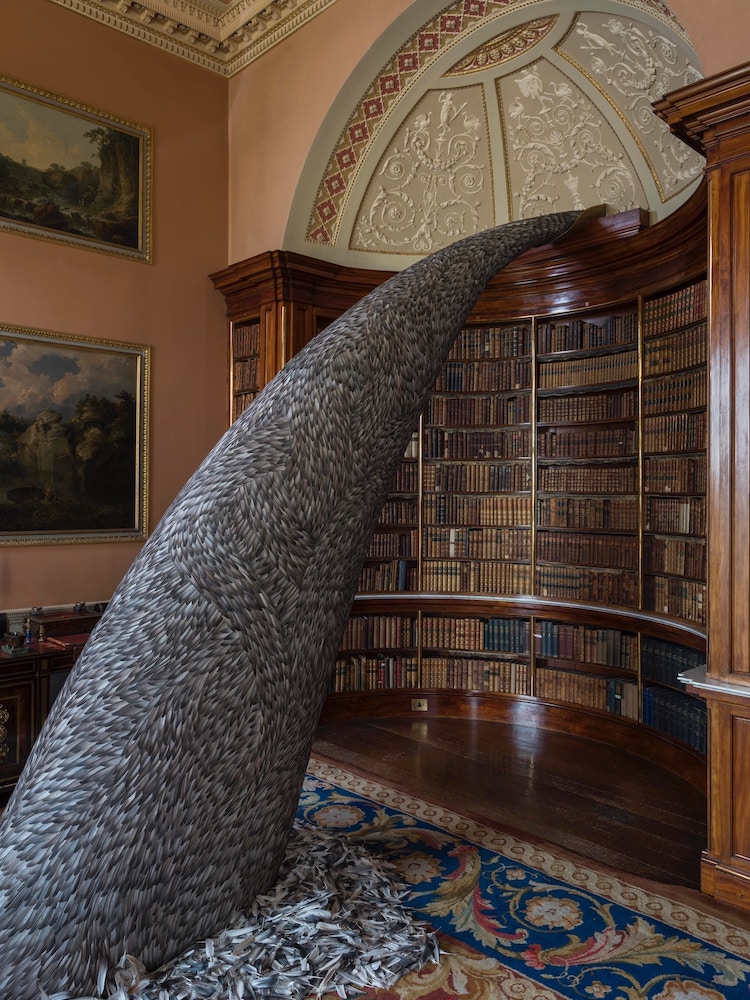
Photo: courtesy of Kate MccGwire
Discharge by Kate MccGwire
Sculptor Kate MccGwire views the use of repurposed materials as central to her creative practice. Her installation Discharge is an incredible example of how creative reuse can produce striking results. The London-based artist used around 10,000 pigeon feathers to create an explosion trickling from a bookcase.
By carefully sorting the feathers she collected, MccGwire was able to create this dynamic curve filled with abstract shapes. The result is at once mesmerizing and yet could be off-putting for viewers once they realize what the material is. This dual reaction is something the artist looks for, as she attempts to show the public how unexpected materials can be transformed into something aesthetically pleasing and beautiful.
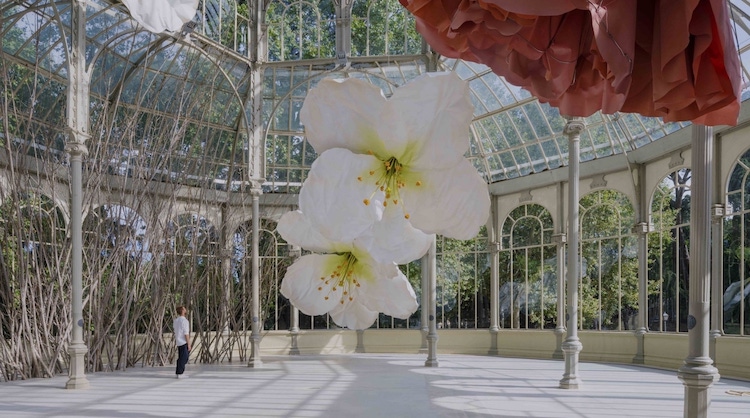
Photo: ImagenSubliminal (Miguel de Guzmán and Rocío Romero)
To a raven and the hurricanes which bring back smells of humans in love from unknown places by Petrit Halilaj
When Madrid's Palacio de Cristal reopened after the initial COVID-19 lockdown, they started with a bang. Kosovar artist Petrir Halilaj put on an incredible display with his installation To a raven and the hurricanes which bring back smells of humans in love from unknown places. Inspired by the mating rituals of bowerbirds, he filled the space with enormous, oversized flowers.
The flowers were made in collaboration with Halilaj's life partner, Álvaro Urbano; and, in fact, the entire piece is meant to be a celebration of love. By declaring their love openly, they are starting a wider dialogue about acceptance and identity.
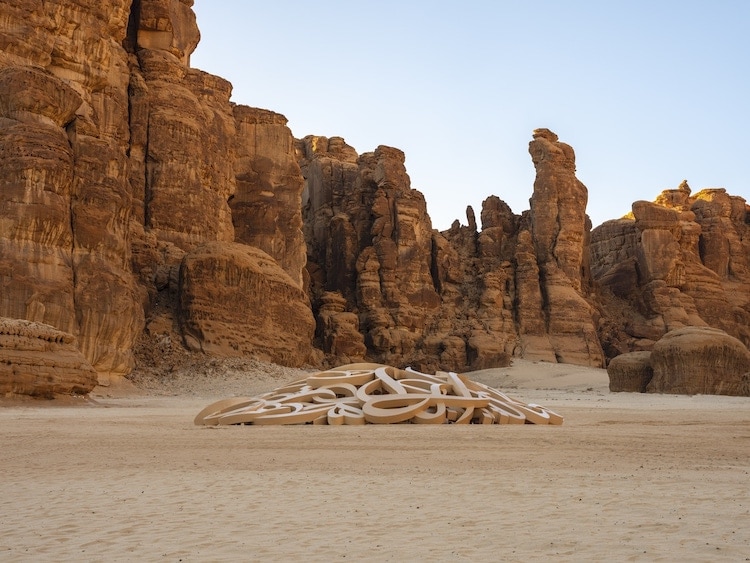
“Mirage” by eL Seed (Photo: Lance Gerber)
Desert X AlUla
Early in 2020, before most of the world was shut down, 14 artists traveled to the Saudi Arabian desert to create their own art oasis. Desert X AlUla is groundbreaking for Saudi Arabia, with a diverse lineup of young artists that included many women. Each artist was asked to use the desert as their canvas, and they all delivered.
Many created interactive pieces that invited visitors to engage with the art. From installations that visitors could swing on to artificial puddles that were meant to be jumped upon, each artwork is a reflection of its artist. Some, like eL Seed even took direct inspiration from the surroundings. His work Mirage is based on a 7th-century love story from the area.
“When I arrived in AlUla, I realized it would be impossible for me to compete with the environment,” eL Seed shared. “So I decided to create a work that would blend into the desert. Jameel and Butheyna were never able to be together. That’s also a mirage. Love is universal. It unites us all.”
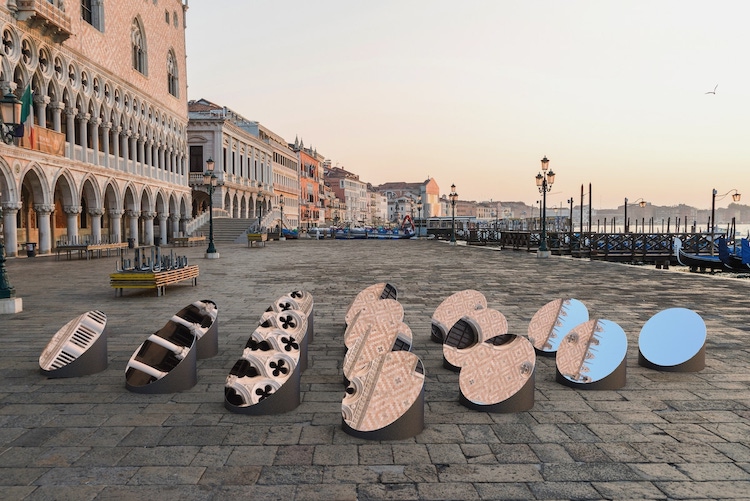
Photo: courtesy of Arnaud Lapierre
AZIMUT by Arnaud Lapierre
Venice is already beautiful and, by harnessing its beauty, designer Arnaud Lapierre created a memorable installation. Using strategically placed mirrors that rotate, Lapierre's AZIMUT reflects back fragments of the surroundings. Each mirror contains an unexpected detail of Venice's historic architecture, which allows viewers to observe them in a new manner.
Unfortunately, this installation was cut short due to the pandemic, but the power of the piece lives on through photos and videos.
Best Art Installations of 2019
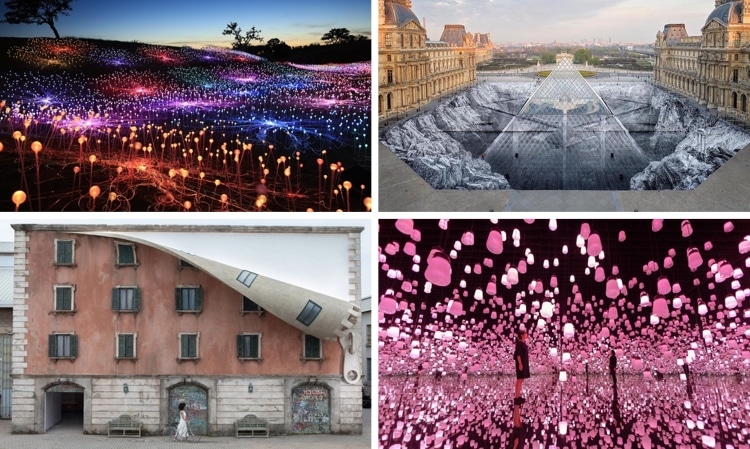
Throughout 2019, artists around the world have been making their voices heard through striking art installations. Whether that means using illusions to transform public spaces or employing light to visually enhance the environment, each artist uses their work to great effect. Since 2013, we've been rounding up the top 10 art installations of the year and 2019 proved as difficult as ever to select the best site-specific works out of a strong pool of art.
Some artists like Vahit Tuna and Lorenzo Quinn used their art installations to highlight social concerns while others were drawn to explore topical issues of climate change and gun violence. Familiar names like Banksy and JR have made the list once again, the former for his surprise Gross Domestic Product pop-up shop that caused a sensation. But not all artists practice their work outdoors. Japanese art studio teamLab made the list for their breathtaking immersive installation that saw a room filled with thousands of Murano glass lamps.
Our top 10 list is filled with legendary contemporary artists like Jenny Holzer and Bruce Munro, both heralded for their site-specific installations. But alongside these big names, we also introduce up-and-comers like DAKU, the Indian artist who is making a name for himself with his shadow art. Check out who made the list of top art installations and then read on for a little background on the history of installation art before looking back over the past years' great art.
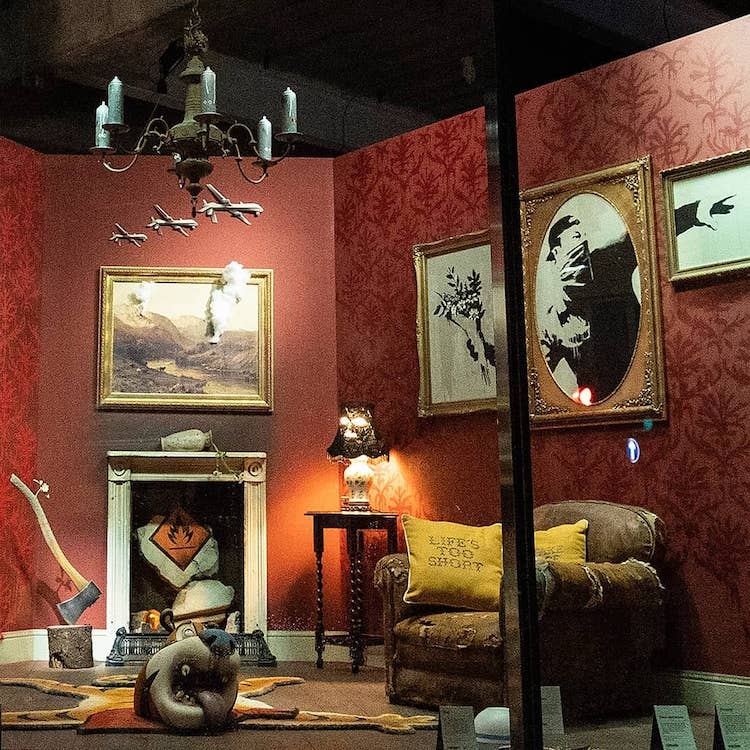
Photo: Banksy
Gross Domestic Product by Banksy
The world's most famous—and most mysterious—street artist made waves once again with an unexpected project. When Banky's Gross Domestic Product seemingly popped up overnight in London, the homewares store that visitors can view but not enter caused a sensation. Banksy used the storefront as a showroom to display items like mugs decorated with his iconic motifs and welcome mats stitched by refugees in a Greek detainment camp. Eventually, shoppers were allowed to register their interest for items via the official Gross Domestic Product website.
So what's the meaning behind the installation? It's actually quite practical. A greeting card company is attempting to seize legal control over the name Banksy. In order to protect himself, the street artist followed a judge’s recommendation to start his own line of branded merchandise. “I still encourage anyone to copy, borrow, steal and amend my art for amusement, academic research or activism. I just don’t want them to get sole custody of my name,” Banksy stated.
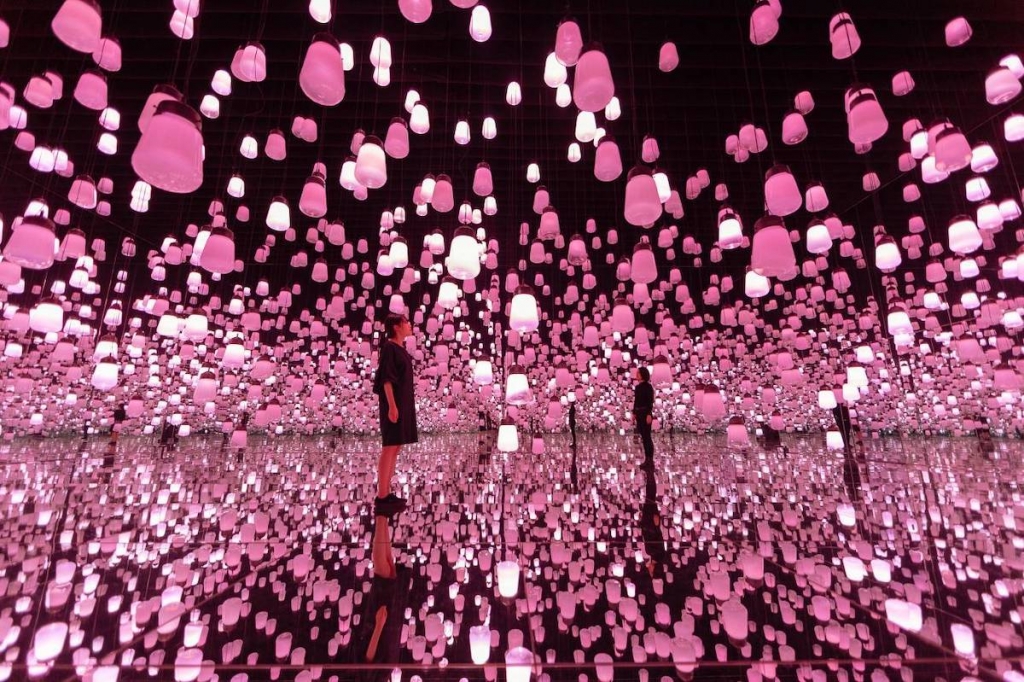
Photo:teamLab
Forest of Resonating Lamps – One Stroke, Cherry Blossoms by teamLab
Japanese art and tech studio teamLab is known for its incredible, immersive installations that explore the relationship between humans and the world through art. Thanks to the teamLab Borderless digital art museum in Tokyo, visitors can explore their vision of light and color on a daily basis. One of the most striking installations in the museum is the Forest of Resonating Lamps.
The interactive installation consists of thousands of Murano glass lamps that follow the movements of visitors with the light they emit. Changing seasonally, the spring installation paid homage to Japan's celebrated cherry blossoms. By weaving gradations of color together, teamLab aims to mimic the Japanese tradition Kasane no Irome—the layering of silks to build color.
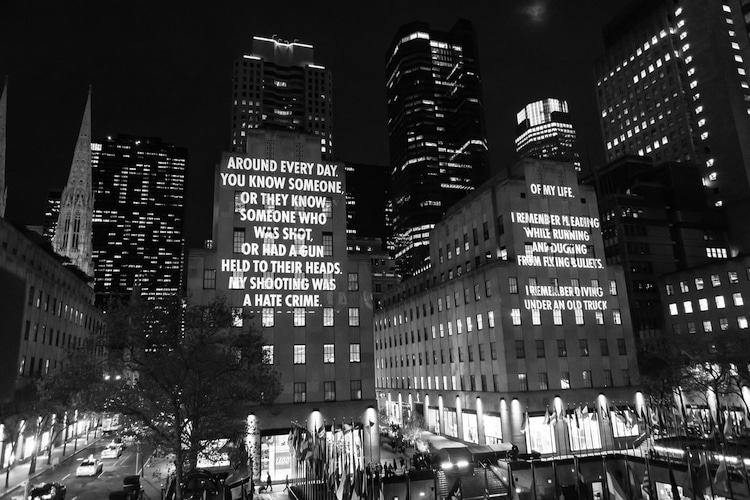
© 2019 Jenny Holzer, member Artists Rights Society (ARS), NY. Presented by Creative Time. (Photo: Lauren Camarata)
VIGIL by Jenny Holzer
Jenny Holzer has a history of using her projected text art to make a stand about important issues. With VIGIL, she used her artistry to shed light on issues of gun control via words splayed across New York's Rockefeller Center. The temporary installation used text from survivors of gun violence, as well as those who have lost loved ones from gunfire.
Presented by New York non-profit Creative Time, VIGIL comes at a time when concerns about gun violence in the United States are at an all-time high. “Jenny Holzer has been an innovator in the field of public art,” said Creative Time Executive Director Justine Ludwig. “It is an honor to work with her to realize this project, addressing one of the most pressing issues we have today as a nation. Her work amplifies the words of those directly affected and brings personal perspective to staggering statistics.”

© 2019 Bruce Munro. All rights reserved. (Photo: Serena Munro)
Field of Light at Sensorio by Bruce Munro
Acclaimed British artist Bruce Munro has been creating his illuminated landscapes for over 15 years. His site-specific art aims to highlight the shared human experience through interconnected glowing orbs. With Field of Light at Sensorio, Monro accentuated the rolling landscape of California's wine country with 60,000 solar-powered LED lights. As they spider out across 15 acres, they form Munro's largest installation to date.
“I hope that the experience allows people to relax and enjoy the shared experience and to walk away with a feeling of inner peace and harmony . . . a gently illuminated landscape that is framed by a star studded sky,” Munro shared with My Modern Met in an exclusive interview. “I would encourage people to be inspired by nature because it truly holds all the answers!”
Field of Light at Sensorio has proved so popular that the installation will remain on view until June 30, 2020.
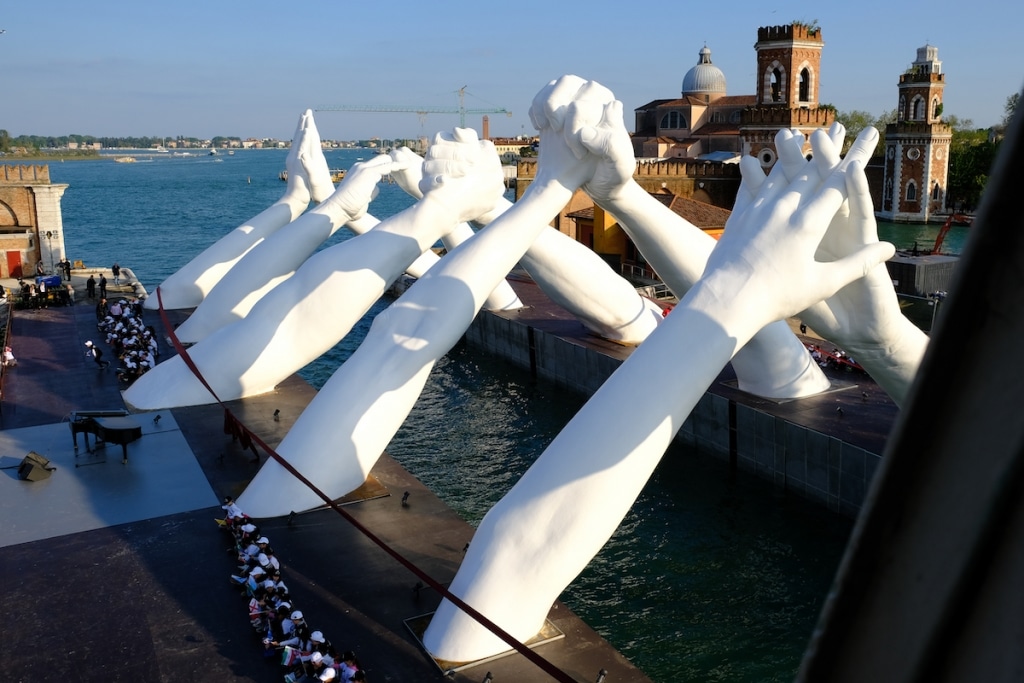
Photo: Lorenzo Quinn
Building Bridges by Lorenzo Quinn
Two years after his widely praised Support installation, sculptor Lorenzo Quinn returned to Venice with Building Bridges. Stretching almost 50 feet high and 65 feet wide, six pairs of hands reached across one of the lagoon's historic canals. Each pair either clasps or touches in a powerful sign of unity.
Created for the 2019 Venice Art Biennale, Building Bridges is based on a message of inclusion that is all too important in these divisive times. “Each pair of the sculpture’s hands celebrate one of six universal human values: Friendship, to build on the future together; Wisdom, to make mutually beneficial decisions; Help, to cement lasting relationships; Faith, to trust in your heart and self-worth; Hope, to persevere in worthwhile endeavors; and Love, the fundamental purpose for it all,” shared Quinn.
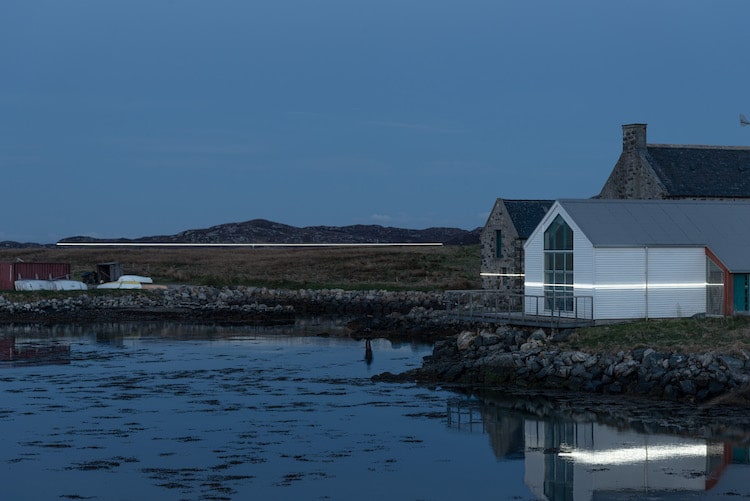
Photo: Pekka Niittyvirta and Timo Aho
Lines (57° 59 ́N, 7° 16 ́W) by Pekka Niittyvirta and Timo Aho
In an effort to visually demonstrate the effects of rising sea levels, Finnish artists Pekka Niittyvirta and Timo Aho used beams of light to create Lines (57° 59 ́N, 7° 16 ́W). The duo worked out of the Taigh Chearsabhagh Arts Centre in Scotland and marked points along the landscape where sea levels could rise to in the near future. The results are a visually stunning, yet shocking, look at what the future might hold.
As the lasers slice across buildings, cutting them nearly in half, the struggle of seaside communities is made real. By thinking about human actions, the environment, and climate change, the artists have been able to demonstrate the imminent consequences of our actions.
“We believe that the topic we are talking about here is one of the most important challenges we are facing,” the artists told My Modern Met in an exclusive interview. “Art has the potential to convey scientific data, complex ideas, and concepts in a powerful way that words or graphs fall short of.”
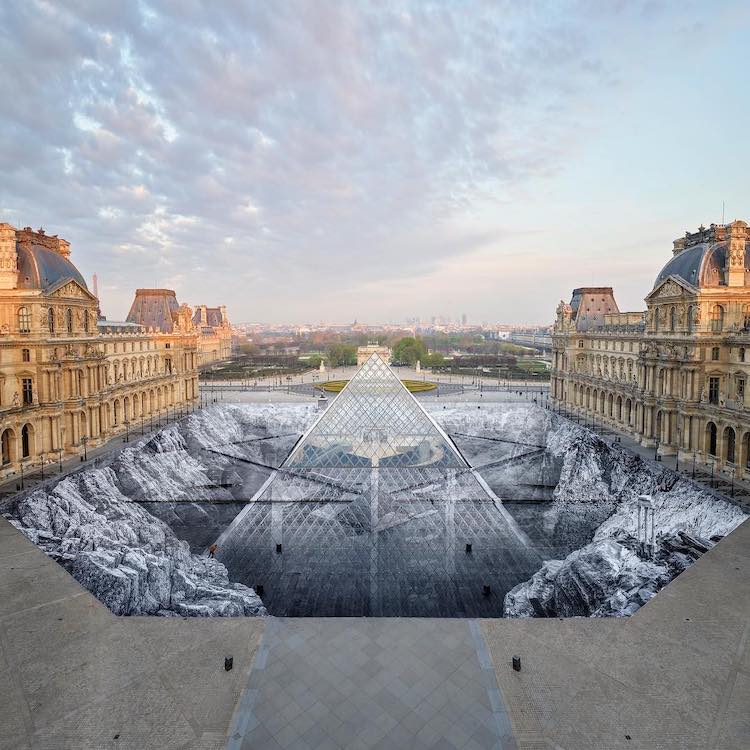
Photo: JR
Louvre Pyramid Illusion by JR
A familiar name on the list, street artist JR continually produces high-quality artwork. In 2019, for the 30th anniversary of the Louvre Pyramid, the French artist created a memorable—though ephemeral—tribute. With the help of 400 volunteers, he strategically placed 2,000 sheets of paper to create the illusion that the Pyramid was rising from a rock quarry.
Once JR posted the photograph of the finished piece to his Instagram, the area was swarmed with tourists and the fragile paper was quickly torn to shreds. While some were upset about the short duration of the installation, for JR it was all about the idea of presence and absence. In fact, JR's response to the fervor via Twitter says it all: “The images, like life, are ephemeral. Once pasted, the art piece lives on its own. The sun dries the light glue and with every step, people tear pieces of the fragile paper. The process is all about [the] participation of volunteers, visitors, and souvenir catchers.”
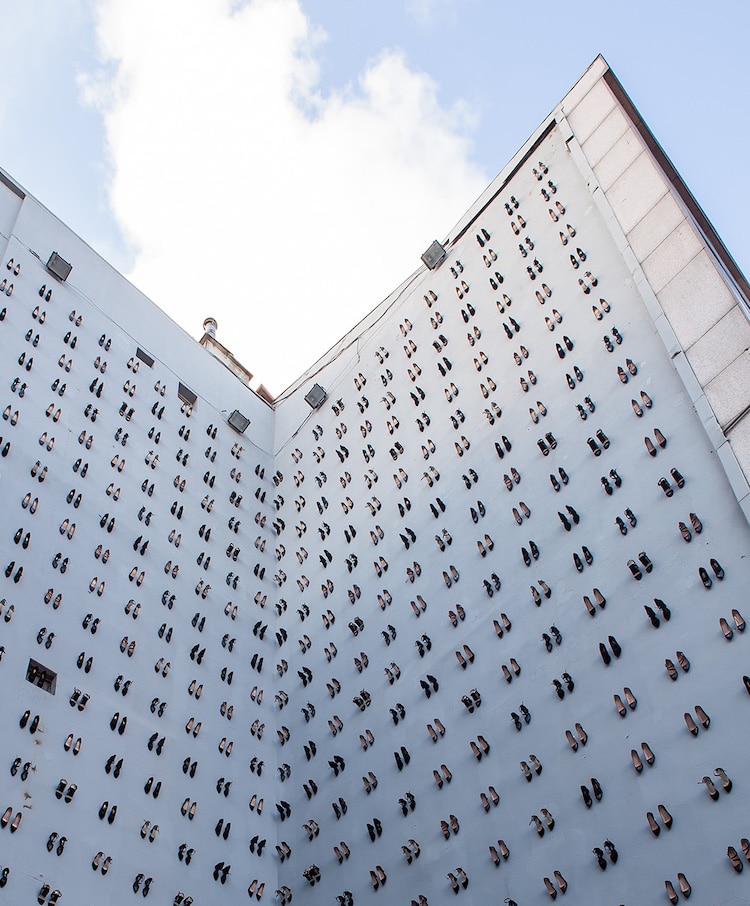
Photo: Yankose
Untitled by Vahit Tuna
By placing 440 pairs of black high heels along the facade of a building, Turkish artist Vahit Tuna is shedding light on the important issue of femicide. Each pair represents a woman killed by her partner in Turkey in 2018, making the installation a stirring and sad reminder of the work that needs to be done to combat domestic violence.
It's impossible to ignore the imposing display, which ran for six months on a wall curated by the non-profit art platform Yanköşe. The use of high heels was inspired by the Turkish custom to hang the shoes of the deceased outside of their house. By transforming this funerary tradition, Tuna gives a wake-up call to the public.

Photo: Marc Wilmot
Milan Design Week installation by Alex Chinneck
British artist Alex Chinneck peeled back layers of history with his installation in Italy during Milan Design Week. In what he called his most ambitious project yet, Chinneck “unzipped” the facade of a building in Milan and allowed a glowing blue light to shine from beneath the masonry.
The incredible illusion carries through to the interior of the building, where Chinneck inserted zippers in the walls and floors. In fact, to achieve the desired effect, he excavated and repoured concrete in different sections of the building. Unfortunately, the zipper's shelf life was short-lived, as the temporary installation was finished after a few weeks.
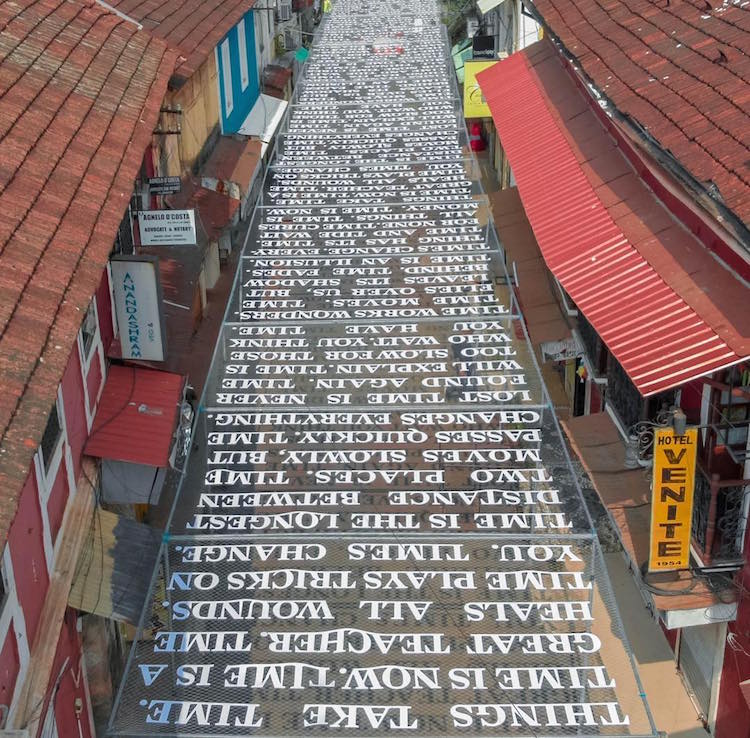
Photo: DAKU
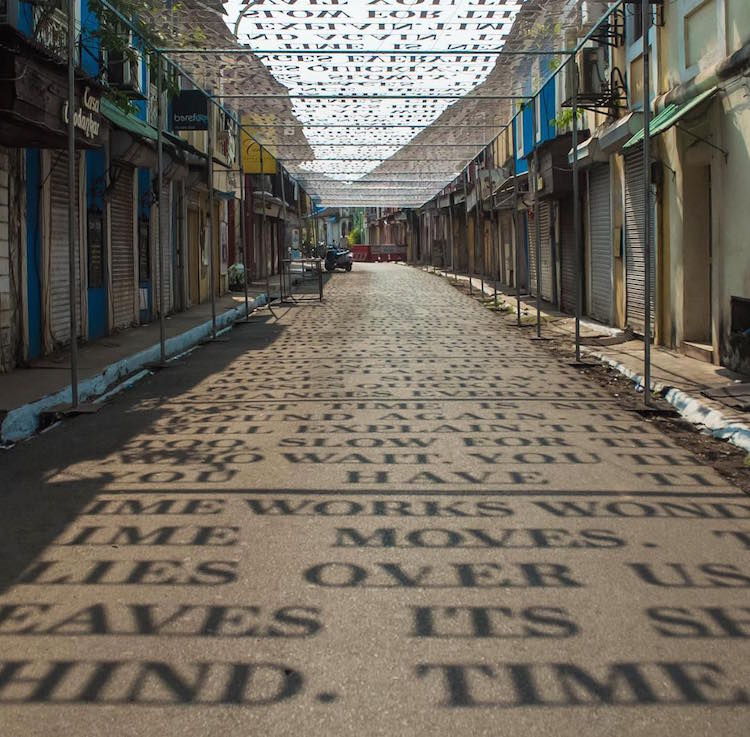
Photo: DAKU
Theory of Time by DAKU
Over the past few years, Indian artist DAKU has made a name for himself thanks to his striking installations that use light and shadow. By carefully studying the path of the sun, DAKU installs words that can only be viewed in their entirety at a precise moment in time. While he often creates these pieces on building facades, Theory of Time saw him filling an entire street in Panjim, Goa with text.
The text moves throughout the day, creating an evocative ebb and flow that mirrors the meaning of the phrases projected on the pavement. “Time is a great teacher” and “Time is an illusion” are just some of the sentences that make DAKU's work an incredible merging site of the visual and metaphorical.
Best Art Installations of 2018

In 2018, we saw an eclectic mix of installation inspiration, but there's no denying that humanity's relationship with nature was a prominent theme throughout the year. Ranging from poignant to playful, these works of art prompted viewers to engage with art from an environmental perspective.
Many of the year's top installations dealt with ocean conservation, including Jason deCaires Taylor's short-lived “inverse zoo,” Courtney Mattison's ceramic coral reef, and StudioKCA's large, litter-crafted whale. Some, like Thomas Dambo's enchanting Troll Hunt, Ernesto Neto's crocheted canopy, and HOTTEA's Scope Art Show installation imaginatively showed appreciation for the natural world, while HYBYCOZO creatively captured the “patterns that appear in nature” with their laser-cut sculptures.
In addition to eco-centric works of art, Culturespaces, Yayoi Kusama, and JR and immersed viewers in artwork inspired by history, human interaction, and personal memories.
Explore these spectacular installations below.
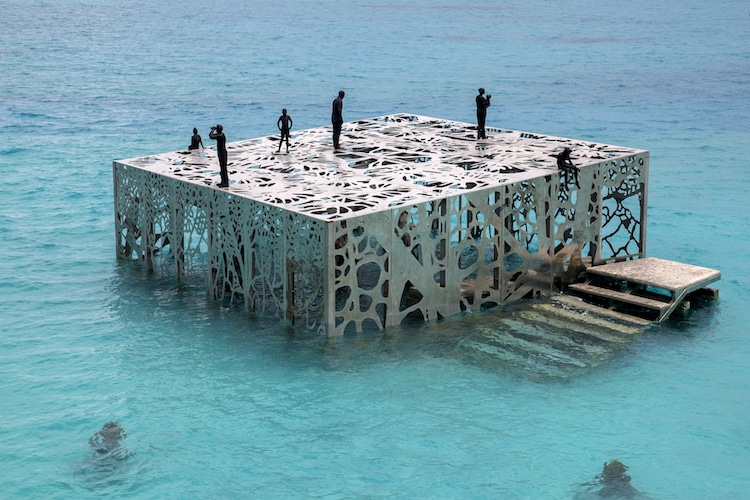
Photo: Jason deCaires Taylor and the Fairmont Maldives
Coralarium by Jason deCaires Taylor
British sculptor Jason DeCaires Taylor uses his practice to advocate for environmentalism. Time and time again, he's wowed the world with his aquatic Earthworks, from solitary cement figures to an entire underwater museum. In 2018, Taylor added a new piece to his ambitious oeuvre: Coralarium, a submerged sculpture gallery.
Like all of Taylor's creations, Colararium transcends its role as a work of art. Made out of punctured pH-neutral marine steel, this colossal cube doubles as an artificial reef, inviting sea creatures to swim around the structure and explore the figures dwelling in its interior.
“It's almost like an inverse zoo,” deCaires Taylor said. “In cities, we go into space and look at caged animals. Whereas this is almost like we’re the tourists, but we’re in the cage and the marine life can come and go and look at us. It’s almost a reversal of how we interact with wildlife.”
Unfortunately, Colararium was destroyed by the Maldivian authorities in September. They deemed the piece “offensive to Islam” due to its depiction of human forms.
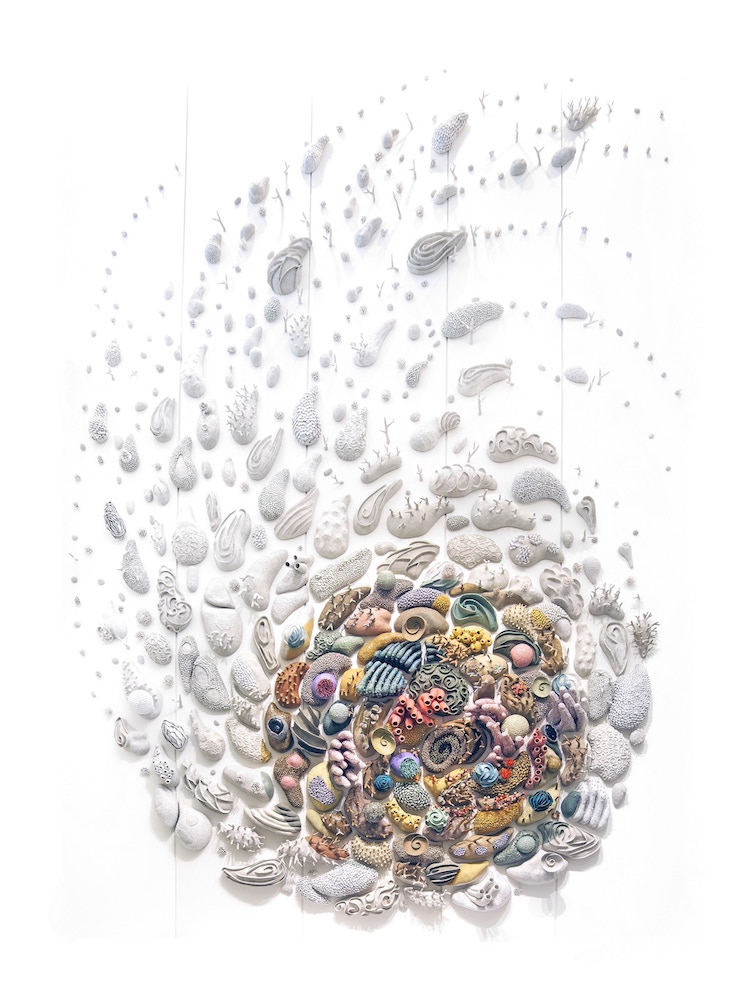
Photo: Courtney Mattison
Confluence (Our Changing Seas V) by Courtney Mattison
Artist Courtney Mattison sculpts ceramic installations that “promote awareness for the protection of our blue planet.” As a part of the Art in Embassies program, Mattison was commissioned to create Confluence (Our Changing Seas V) for the United States embassy in Jakarta, Indonesia.
Like other works in Mattison's Confluence series, this large-scale piece comments on the fragility of the coral reef. Specifically, Confluence (Our Changing Seas V) explores the effects of coral bleaching, as it portrays a cluster of corals, anemones, and sea sponges spiraling into skeletons.
By drawing attention to this issue, Mattison hopes to promote coral conservation and encourage people to seek a solution. “It is possible for coral reefs to recover even from the point of bleaching if we unite and act quickly enough to decrease the threats we impose,” she says. “Perhaps if more people appreciate Indonesia’s spectacular reefs, we will act more wholeheartedly to preserve them for future generations.”
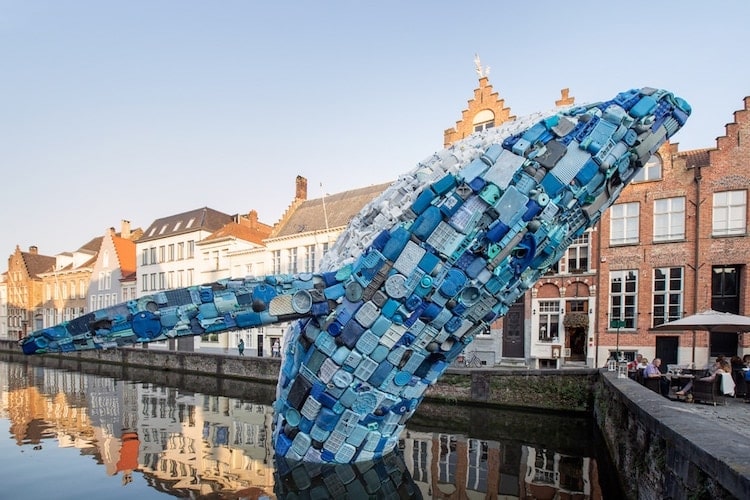
Photo: StudioKCA
Skyscraper (the Bruges Whale) by StudioKCA
For this year's Bruges Triennial, StudioKCA and Hawaii Wildlife Fund collaborated to create Skyscraper (the Bruges Whale), a 38-foot installation. Intended to “show the scope and scale of the problem” with plastic waste, the monumental piece was crafted from 5 tons of litter fished out of the Pacific and the Atlantic Oceans.
StudioKCA opted to call the installation Skyscraper as a nod to the size of the whale. At 4 stories tall, it towers over the medieval buildings that line the Bruges Canal, making it a perfect symbol of the large-scale issue.
“A whale, breaching from the water, is the first ‘skyscraper of the sea,' ” the artist said, “and as the largest mammal in the water, it felt like the right form for our piece to take in order to show the scope and scale of the problem.”
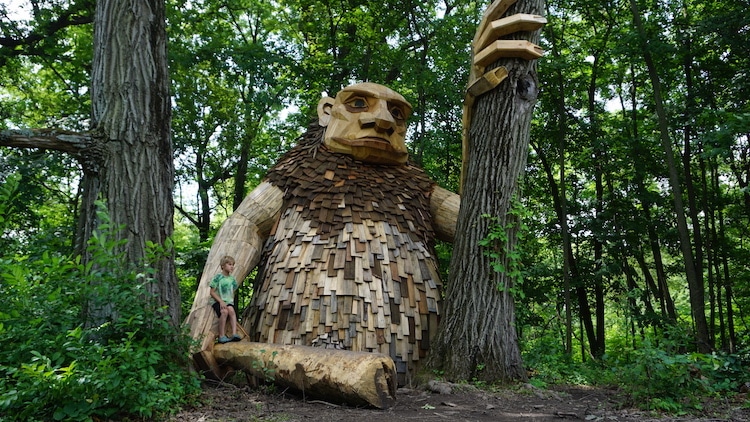
Photo: Thomas Dambo
Troll Hunt by Thomas Dambo
Troll Hunt, an installation comprising six sneaky trolls, popped up in Illinois' Morton Arboretum over the summer. Crafted by Thomas Dambo, these peculiar figures are made out of reclaimed wood, showcasing the artist’s ability to make “anything you can imagine out of trash.”
Once assembled, these site-specific sculptures came to measure anywhere from 15 to 60 feet tall. Though massive in size, Dambo skillfully hid the crafty trolls in the arboretum, inviting guests to use their Troll Hunter's Handbook to track them down.
Though initially slated to last only through 2018, this installation will be on-view into the new year. Depending on weather, it may even last until summer 2019.
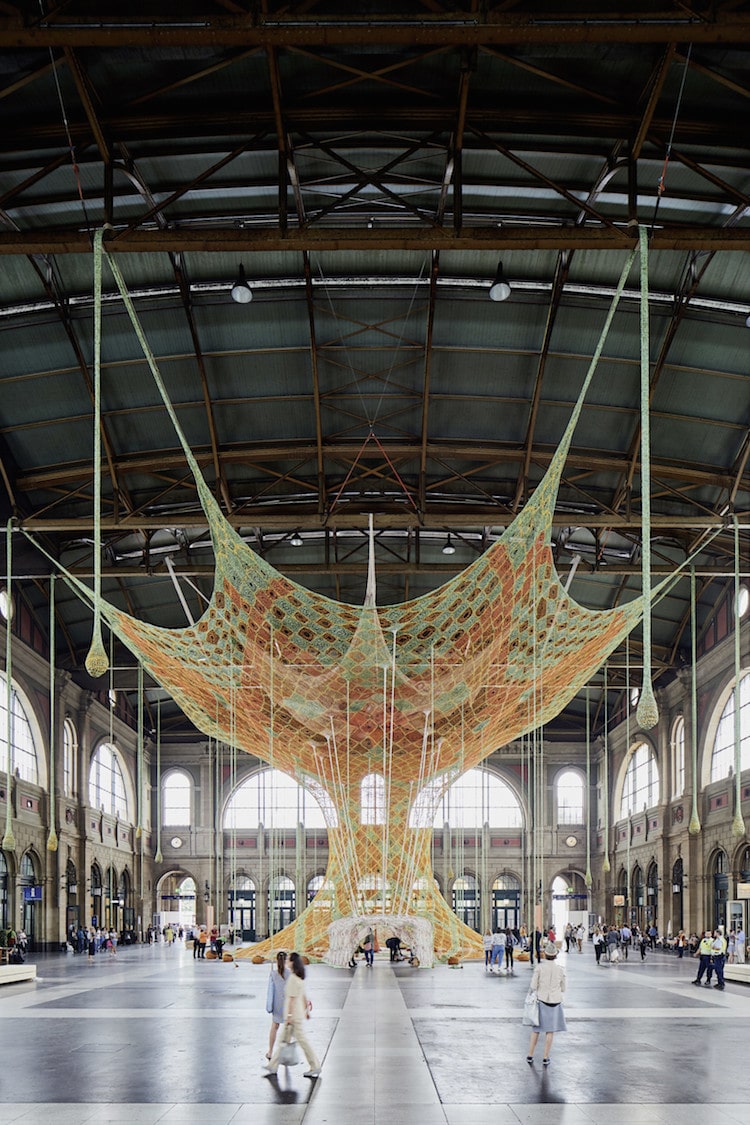
Photo: Fondation Beyeler
GaiaMotherTree by Ernesto Neto
With his large-scale installations, conceptual artist Ernesto Neto “explores constructions of social space and the natural world by inviting physical interaction and sensory experience.” In 2018, he collaborated with Fondation Beyeler to create GaiaMotherTree, a crocheted structure that took root in Zurich’s Central Station.
This immersive work invites members of the public to step inside of its draping canopy and escape the hustle and bustle of the station. Once inside, they can observe the piece from a new perspective and experience another interactive layer of the installation: smell.
The “branches” of the tree are weighted with bags of spices. As the fragrant scents of turmeric, cloves, cumin, and black pepper waft through the air, viewers are invited—and reminded—to take a deep breath. “The idea is to slow down our time, for us to have time to breathe and feel life inside of us,” the artist says. “This work is all about intimacy.”
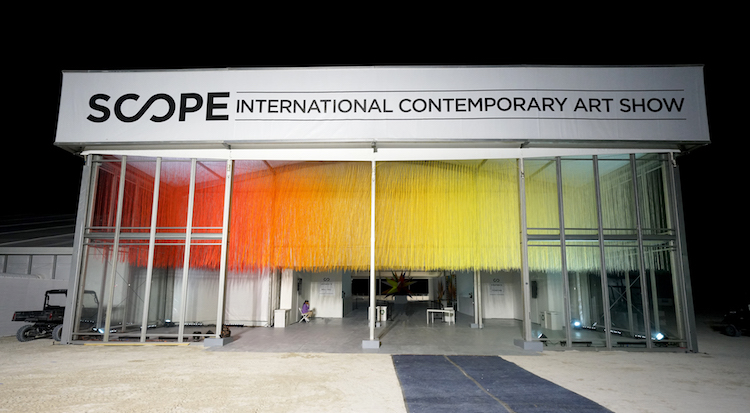
Photo: HOTTEA
SCOPE Miami Installation by HOTTEA
Eric Rieger, also known as HOTTEA, creates sentimental yarn art inspired by memory. Since foregoing his spray-paint practice for something more meaningful, the former graffiti artist has crafted a collection of vibrant fiber installations. In 2018, he created a show-stopping work of art that welcomed visitors to SCOPE Miami Beach—a popular satellite art fair in Florida—with a dazzling gradient of rainbow color.
Tasked with creating a site-specific piece that would only be on view for one week, HOTTEA was determined to design an eye-catching installation whose message would have a lasting impact. “My installation for SCOPE Miami 2018 was inspired by the idea of taking things for granted,” HOTTEA told My Modern Met. “Even though we may take things for granted, once they are gone we wish we would have acted differently. Our sun, rain, wind, plants, animals, people, everything could disappear in seconds and when they do it is our memory of them that will carry on assuming there is something beyond our existence here on earth. What I hope people took away from my installation was not only a color experience they will not forget but also a reminder of how much a singular moment can mean.”

Photo: HYBYCOZO
Installations in No Spectators: The Art of Burning Man by HYBYCOZO
Over the last few years, HYBYCOZO has taken Burning Man by storm with their installations. However, in 2018, the duo plucked their laser-cut polyhedrons from the desert and placed them in the museum for No Spectators: The Art of Burning Man.
Presented by the Renwick Gallery in Washington DC, this unique exhibition shows the work of HYBYCOZO in a new light. Three of their pieces—Inner Orbit: Lvov, Deep Thought, and Trocto—are included in this exhibition, illuminating the gallery's walls with a dance of light and shadow.
No matter the context, HYBYCOZO hopes that all of their installations prompt “a sense of curiosity and wonder about the geometry of the shape and the meaning of the pattern” from all viewers.
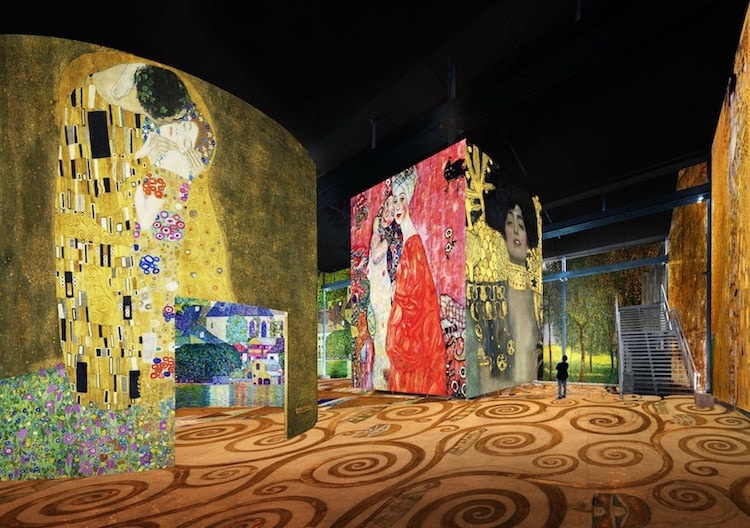
Photo: Culturespaces
Atelier des Lumières by Culturespaces
Culturespaces uses unique multimedia equipment to create and curate digital shows that “add dynamism to artistic practices, amplify emotions, and reach the largest possible audience.” This modern approach to exhibition is the driving force behind the Austrian art installation at Paris' Atelier des Lumières.
Featuring 3,000 moving images made by 20 laser video projectors, this installation highlights the work of Viennese artists, including Egon Schiele, Friedensreich Hundertwasser, and—most prominently—Gustav Klimt.
In addition to The Kiss and other works on canvas, this exhibition features projections of Klimt's epic Beethoven Frieze, inviting “visitors who have never had the opportunity to visit the Secession Palace in Vienna to behold the iconic figures in Klimt’s frescoes” with a technological twist.
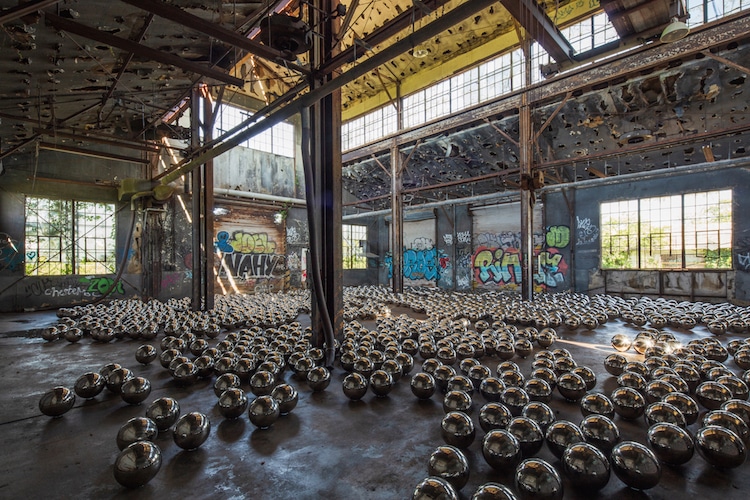
Photo: Yayoi Kusama / MoMA PS1
Narcissus Garden by Yayoi Kusama
In 1966, Yayoi Kusama debuted her first Narcissus Garden. Intended to comment on the vanity and commercialization of contemporary art, the installation featured a field of reflective spheres—an element still present in today's iteration at MoMA PS1.
For 2018's Narcissus Garden, Kusama filled an abandoned U.S. military base in Fort Tilden with 1,500 stainless steel, mirrored balls. Much like previous editions, the spheres are intended to draw attention to the surrounding space and prompt viewers to contextualize their own reflections within this bigger picture.
Narcissus Garden was commissioned for Rockaway!, a free public art festival founded to support the redevelopment of New York’s Rockaway Peninsula area following Hurricane Sandy in 2012.
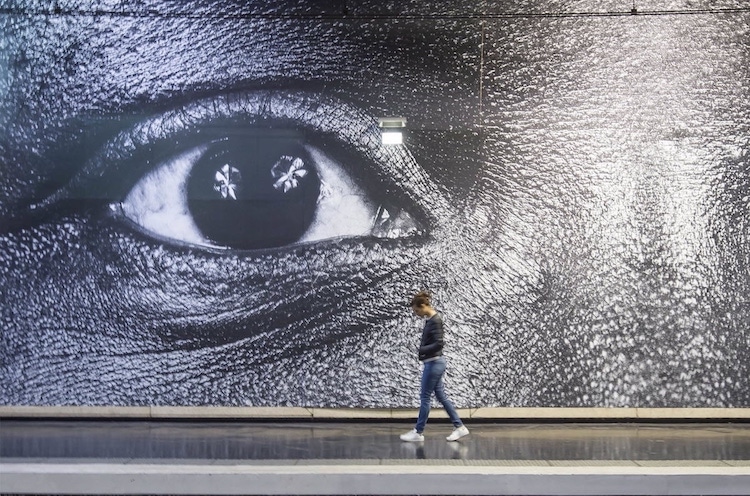
Photo: RATP
Voyage avec d’autres by JR
In 2018, the eye-catching photographs of French street artist JR invaded Paris' railways. Commissioned by the Paris transit operation RATP, Voyage avec d’autres (“Traveling with Others“) brought a bit of art to some of the city's most bustling sites.
For this project, JR placed monumental photographs of people's eyes in 11 of Paris' metro and train stations. After a few weeks or installation, JR decided to gradually replace the existing artworks with new portraits taken by the artist in the very stations they adorn.
By rotating these new photos of “people passing in front of the previous eyes” into the series, JR creatively blurs the line between subject and spectator.
Best Art Installations of 2017

Given the prominence of politics this year, many of 2017's top art installations are rooted in social issues and environmental awareness. These pieces aim to inform the public through strong visuals and striking subject matter, and often invite viewers to reach their own conclusions through contemplation.
Many pieces, like JR‘s immigration-inspired installation and Ai Weiwei‘s powerful piece on asylum seekers, question the current rules on migration. Some, including Lorenzo Quinn‘s site-specific Support sculpture and Captain Boomer Collective‘s hyperrealistic beached whale, comment on climate change. And others, like Greyworld‘s Garden of Light and Kristen Visbal‘s Fearless Girl, shine a spotlight on those who deserve recognition.
While hard-hitting issues clearly stole the show over the last 12 months, some artists—including Edoardo Tresoldi, Rebecca Louise Law, and Emmanuelle Moureaux—forewent this activist approach and instead opted for a more conceptual (and less politically-charged) practice.
Be sure to catch a glimpse of these amazing installations below.
Mexican Border Wall Installation by JR
Celebrated street artist JR is known for his large-scale, photographic installations. For his latest piece, the French artist placed a poster of a toddler along the border between Mexico and the United States. Installed on the southern side of the wall, the piece depicts the young child as he curiously peers over the obstruction.
The image of the innocent boy emphasizes the emotional impact of the United States' immigration policy and humanizes those who are affected by it—a message directly in-line with JR's altruistic approach to art. “I think there is no such thing as art trying to change the world,” JR explained to us in an exclusive interview. “But being an artist and creating art in tons of different contexts, no matter what the mood is and sometimes against the codes that stand around you, is a way of breaking society and changing the world—just by trying.”
Garden of Light by Greyworld
In the spring, Garden of Light—a poignant and powerful collaboration between Marie Curie, a British charity that offers support to terminally ill individuals, and Greyworld, an artists' collective—lit up London and launched the Great Daffodil Appeal with a field of illuminated flowers. Each of the touching exhibit's 2,100 dazzling daffodils represented a selfless Marie Curie nurse and referenced the caregivers' amazing ability to offer “light in the darkest hours.”
In addition to a visual spectacle, the exhibition also featured recordings of nurses reading moving letters they've received from families of patients and invited visitors to commemorate a lost loved on its memory wall.
Law of the Journey by Ai Weiwei
Activist and artist Ai Weiwei is renowned for his powerful and politically-charged works of art. With an interest in current events, the Chinese artist has recently turned his attention to the refugee humanitarian crisis. This focus is evident in Law of the Journey, a powerful installation that depicts a rubber raft filled with refugees. Though the asylum-seekers are clad in lifejackets, many of them have not survived the perilous journey, as numerous bodies surround the overcrowded boat.
To Ai Weiwei, this image is all-too-familiar, as he himself is a refugee. Through his art, he hopes to bring attention to the heartbreaking issue, as he—like many people—believes that “in dealing with refugees, we’ve lost our very basic values.”
Support by Lorenzo Quinn
For the 57th International Art Biennale, artist Lorenzo Quinn created Support, a site-specific sculpture of a set of helping hands. Installed along the wall of the Ca' Sagredo Hotel, the colossal hands appear to emerge from the water of the Grand Canal in order to “support” the seemingly sinking historic building.
Through this piece, Quinn aims to highlight the destruction the “City of Water” could soon face as a result of climate change. “Venice is a floating art city that has inspired cultures for centuries,” the artist explains, “but to continue to do so it needs the support of our generation and future ones.”
Fearless Girl by Kristen Visbal
Empowered by January's worldwide Women's March, many works of art featured a feminist focus in 2017, including the famed Fearless Girl. Commissioned by State Street Global Advisors, the site-specific sculpture was created by bronze artist Kristen Visbal. Strategically installed across from Wall Street's well-known Charging Bull statue, the life-sized piece depicts a small girl defiantly challenging the charging animal.
A call-to-arms for equality in the workplace, Visbal hopes that Fearless Girl is a “piece of work all women of any age, shape, color or creed can relate to” and that it continues to serve as a much-needed reminder that “today’s working woman is here to stay and has taken her place in the nation’s financial district.”
Wire Mesh Environment by Edoardo Tresoldi
With classical architecture as his muse and mesh as his medium-of-choice, Italian artist Edoardo Tresoldi exquisitely crafts old-meets-new works of art. For a royal event in Abu Dhabi, the artist collaborated with DesignLab Experience to create a one-of-a-kind immersive environment that filled the event's 7,000-square-meter space. Though inspired by ancient architecture, the avant-garde aesthetic of the wire sculptures culminated in a highly contemporary installation.
The Iris by Rebecca Louise Law
For The Iris, London-based artist Rebecca Louise Law employed real flowers to explore and embrace the ephemerality of the environment. Created for NOW Gallery, the site-specific show featured 10,000 freshly-cut irises. Suspended from the ceiling using copper wire, the upside-down flora float above the gallery's floor and transform the space into an interactive work of art.
While, at first, the flowers retain their shape, color, and smell, they will soon die. To Law, this is both a beautiful and necessary part of the process, as she continuously strives to create “artwork that can be observed without the pressure of time.”
Eclipse by FAHR021.3
Portugal-based collaborative team FAHR021.3 crafts immersive installations that creatively alter environments. To add a contemporary touch to Porto's Amor de Perdição square, FAHR021.3 installed Eclipse, a metallic purple, 6-meter-tall sphere. Composed of slanted tubes, the massive orb—described by FAHR021.3 as “a game of perception and provocation in the city”—both playfully distributed light and invited passers-by to use it as a unique means to observe their surroundings.
Hyperrealistic Sperm Whale by Captain Boomer Collective
Over the summer, a shocking sculpture of a dead sperm whale appeared on the otherwise beautiful banks of the River Seine in Paris. Created by Captain Boomer Collective, this 17-meter-long hyperrealistic whale has been “beached” in a series of European cities, including Valencia, Antwerp, and London.
Captain Boomer Collective hopes to raise environmental awareness by confronting an unsuspecting public with the grisly installation, described by the team as “a gigantic metaphor for the disruption of our ecological system.”
Forest of Numbers by Emmanuelle Moureaux
French architect and designer Emmanuelle Moureaux is known for her colossal and colorful paper installations. In 2017, she created Forest of Numbers, an interactive and immersive piece crafted from 60,000 paper cut-outs. Intended to represent the upcoming decade, the cut-outs featured the numbers 0 through 9 and were suspended from the ceiling in groups of 4, culminating in 10 layers, or “years.” Thus, as visitors walked around the exhibit, they were conceptually traveling through time.
Along with Color Mixing, I Am Here, and Bunshi, Forest of Numbers is part of Moureaux's 100 Colors series.
Best Art Installations of 2016
Year after year, we are impressed by the inventive and imaginative art installations that pop up in museums, streets, and natural landscapes around the world. From sculptural works and found objects to light art and projections, installation pieces play with space to challenge our traditional perceptions of art engagement.
Like the year before, 2016 saw a wide range of beautiful, fascinating, and poignant installations. While 2015's top works indicated a trend toward dazzling, kaleidoscopic color, this year's best installations are a bit more eclectic and conceptual, presenting an array of aesthetics and unique undertones.
Take a peek at our favorite installations below.
JR au Louvre by JR
Using photographic prints, French street artist JR camouflaged I.M. Pei's iconic glass pyramid at the world-famous Musée du Louvre in Paris. When viewed from a precise angle, the structure appears to vanish, revealing the façade of the stunning palace-turned-museum.
The Blood Forest by Philippe Echaroux
To draw attention to the destruction of the Amazon, artist Philippe Echaroux created The Blood Forest, a striking series that projects portraits of the indigenous Suruí tribe members onto its trees.
The Rubicon by Jason deCaires Taylor
Museo Atlantico is an underwater contemporary art museum located off the coast of the Lanzarote Island in the Atlantic Ocean. For the unprecedented site, artist Jason deCaires Taylor has sculpted a series of hyperrealistic figures that appear to aimlessly stroll along the seabed.
Hollow by Katie Paterson and Zeller & Moye
Hollow, an interactive installation by artist Katie Paterson and architects Zeller & Moye, features wood from 10,000 species of trees spanning millions of years. Cut into planks and crafted into a stalactite-like collection, the wood hangs from the ceiling, offering visitors a unique, walk-through viewing experience.
The Floating Piers by Christo
Contemporary conceptual artist Christo is renowned for his pioneering land art. For his latest site-specific project, The Floating Piers, Christo created a series of bright yellow paths that invites residents and visitors of Sulzano, Italy, to commute to its neighboring islands on foot. Like all of Christo's installations, the local landscape of The Floating Piers plays an important role in its concept. “The mountains surrounding the lake will offer a bird’s-eye view of The Floating Piers, exposing unnoticed angles and altering perspectives,” he explained. “The water, the wind, the sun – all this is part of the project.”
Labyrinth by Motoi Yamamoto
With only standard table salt and a steady hand, Japanese artist Motoi Yamamoto has meticulously transformed the floor of a medieval castle in the South of France into a stunning, spiraling labyrinth.
#SafePassage by Ai Wei Wei
Known for his activist art, Ai Weiwei is no stranger to social statements. For #SafePassage, the leading contemporary artist boldly covered the pillars of Berlin's Konzerthaus with over 14,000 bright orange life vests. Accompanied by a hanging lifeboat transcribed with the hashtag, “#safepassage,” the installation calls attention to the plight of refugees seeking asylum in Europe.
Plexus 35 by Gabriel Dawe
Composed of colorful embroidery threads and intentionally surrounded by old masterworks, Mexican artist Gabriel Dawe‘s enchanting, site-specific installation, Plexus 35, adds a contemporary touch to the Toledo Museum of Art's Great Gallery.
The Canopy by Rebecca Louise Law
Artist and gardening enthusiast Rebecca Louise Law combined her two passions to create The Canopy, a bright and beautiful installation made up of 150,000 native Australian flowers. Using copper wire and a wide variety of blooms, Law seamlessly composed the canopy, which adorned the skylight in Melbourne's Eastland Shopping Mall.
Tili Wiru Tjuta Nyakutjaku by Bruce Munro
While British artist Bruce Munro has created various versions of Field of Light, a large-scale, luminous work, it wasn't until 2016 that he finally installed a light installation on the site that inspired it all—Uluru, a sandstone monolith in Australia. Titled Tili Wiru Tjuta Nyakutjaku (“looking at lots of beautiful lights” in Pitjantjatjara, the local language of the region's Aboriginal people) the dazzling display is on view until 2017.
Best Art Installations of 2015

What we love most about art installations is that they have the power to transform–not only the spaces they inhabit, but also our own perceptions of space, color, form, and more. These exhibits remind us that a plain, white-walled room, an empty chapel, and a market filled with bustling crowds can serve as an artist's canvas. 2015 definitely raised the bar with its immersive, playful, and even thought-provoking exhibits.
To see exactly what we mean, scroll down and take a look at fifteen of our favorite art installations that delighted the world this year.
When My Father Died It Was Like a Whole Library Had Burned Down by Susanna Hesselberg
Swedish artist Susanna Hesselberg constructed a library that plunges into an infinite abyss. Visible only from above ground, the intriguing installation is inconspicuously marked and, from a distance, looks as though it's just a square frame laying on the grass. As viewers approach it, however, they can easily see the stacks of books descending into the earth. Its compact structure is reminiscent of a mining shaft or water well with no apparent bottom.

Read more: Kaleidoscopic Installations Made of Thousands of Pieces Crawl Across Floors, Walls, and People
Installation Arnhem by Suzan Drummen
Suzan Drummen shows a keen eye for detail with her dazzling kaleidoscopic floor installations that take on a three-dimensional form with their complexity. This Netherlands-based artist works with thousands of individual elements, placed loosely about the floor, or fixed onto walls with pins; occasionally, bedazzled participants aid in forming these lively illusions. Her pieces are constructed from crystal, chrome-plated metal, precious stones, mirrors, and optical glass. When combined, these ornamental components certainly enlivened an empty wooden chapel for Drummen's Installation Arnhem piece.
Dear World… Yours, Cambridge by Miguel Chevalier
Artist Miguel Chevalier created a series of immersive projections that added a mesmerizing flair to a University of Cambridge charity event. The fundraising occasion featured Chevalier's designs front and center in the King's College Chapel, as they cloaked the historic interior in a myriad of changing colors, patterns, and textures. It was a striking juxtaposition that fused contemporary imagery with 16th-century Gothic English architecture–a mashup of old and new that brought the building to life.
Mirrored Room by Lucas Samaras
New York-based artist Lucas Samaras is known for his wooden chambers covered top to bottom with mirrors that transform the spaces into dazzling, dizzying infinity rooms. Utterly captivating, each room invites viewers to step into a world of endless reflections and refractions. Stretching limitlessly in all directions, the mirrored space gives the viewer the surreal experience of floating weightlessly in an abyss devoid of any sense of time or place. The artist's most famous infinity room installation, Room No. 2 (a.k.a. Mirrored Room), was on display at NYC's Pace Gallery in August.
Love Mondays by Gemma Cairney and Spark Your City
Commuters in London were treated to a delightfully colorful surprise one June morning, when the London Bridge was turned into a rainbow pathway stretching 300 meters across the Thames River. The cheery installation was the work of BBC 1 presenter Gemma Cairney and Spark Your City, a global movement “dedicated to spark joy in everyday city life.” Cairney and her collaborators were up bright and early to make sure the rainbow road was in place by the time commuters were on their way to work. With the colorful tiles, a multi-hued outfit, free bouquets of flowers, and a sign inviting people to “Love Mondays,” Cairney was a welcome beam of sunshine to Londoners on that gray, rainy morning.
In Infinity by Yayoi Kusama
For years, we've been enamored with the colorfully dazzling work of Japanese artist Yayoi Kusama. Her awe-inspiring installations feature a dizzying amount of dots that engulf the viewer in a fantastical, dreamlike world. In October, she took over the south wing of the Louisiana Museum of Modern Art in Denmark with her first comprehensive, retrospective exhibition. Called In Infinity, it presents multiple works that capture the essence of her artistic language and fascination with cosmological and psychological spaces.
Lucent by Wolf Buttress
Artist Wolf Buttress created a sculptural installation that looks like a giant dandelion wafting in the breeze. Its center, surrounded by delicate, tiny florets, mimics the flower's wispy shape and feel. Titled Lucent, this larger-than-life orb is suspended above a darkened, reflecting pool that mirrors the brilliant illuminated tips, doubling its stunning presence. Although it has the soft appearance of a dandelion, Buttress produced Lucent with another, much larger, natural body in mind–the universe. The installation's name (derived from the Latin “to shine”) and its 3,115 hand-blown glass spheres represent stars on a map that are visible to the naked eye from the Northern hemisphere.
Plexus A1 by Gabriel Dawe
Artist Gabriel Dawe has done it again, this time with a dazzling piece entitled Plexus A1. This mesmerizing rainbow of color appears to be some sort of architectural sculpture, but in reality, it's created from vibrant strands of thread. As part of his ongoing Plexus series, this multicolored optical illusion–composed of over 15 different hues–stretches to the space's 19-feet-high ceilings and features nearly 60 miles of thread. To create this larger-than-life visual and spatial art piece, the artist used a self-made giant needle formed from an extension rod.
Projecting Change: The Empire State Building by Louie Psihoyos and Fisher Steven
Back in August, the iconic Empire State Building in New York City was transformed into a moving tribute to endangered animals around the world. This spectacular light show, called Projecting Change: The Empire State Building, was organized by director Louie Psihoyos and producer Fisher Stevens of the Oscar-winning documentary The Cove, a film that explored dolphin hunting in Japan. The duo collaborated with Obscura Digital co-founder Travis Threlkel on the projection, which was illuminated from 9PM to 12AM and featured a looping reel of “Noah's ark” animals.

Read more: New York Art Installation Invites Adults to Release Their Inner Child and Dive Into a Giant Ball Pit
JumpIn! by Pearlfisher
Who says ball pits are only for kids? Creative agency Pearlfisher put together an interactive art installation for adults, which just so happened to be a giant ball pit made of 81,000 white plastic balls! This immersive installation made its way to the U.S. after a successful debut in the United Kingdom. In taking this interactive exhibit around the world, the creative agency hopes to remind visitors that playing around can positively promote creative thinking. While diving into a sea of plastic balls may seem childish, it does allow grown-ups to unwind after a stressful day at work. It gives them a sense of freedom and reinforces the fact that a work-life balance is extremely important.
Crystal Universe by teamLab
Japanese tech art studio teamLab invites viewers to step into a galaxy of twinkling lights in Crystal Universe, their fully immersive installation. The Tokyo-based collective positioned 60,000 suspended LEDs in a three-dimensional space, using their original 4D Vision technology to create the dazzling appearance of an infinite number of light particles cascading endlessly in all directions.
The Dance by Benjamin Shine
London-based artist Benjamin Shine put his incredible fabric-folding skills to the test for his latest “paintings” crafted from sheets of tulle. The Dance features the amazingly realistic faces and elegant frames of dancers constructed from over 2,000 meters of suspended tulle. Shine painstakingly folded, pleated, ironed, and hand-sewed the gauzy material until lifelike features and graceful limbs began to take shape in the clouds of purple, pink, and blue material. Intricate details are revealed through contrast created by backlights shining through the wispy layers of fabric.
Flower House by Lisa Waud and Florist Collaborators
What does it look like when you give florists 48 hours to fill an old, abandoned house with flowers? During the third week of October 2015, talented florists from across the United States revived a dilapidated Detroit home with between 60,000 and 100,000 flowers. After Lisa Waud‘s enthralling Flower House installation came to a close, it was later responsibly deconstructed so its materials could be repurposed. The formerly neglected land is now being converted into a flower farm and design center so its floral legacy can continue on.
Heartbeat by Charles Pétillon
From August 27 to September 27, the 19th Century Market Building in London's Covent Garden was home to 100,000 giant white balloons, an installation aptly titled Heartbeat. This awe-inspiring display is the work of French artist Charles Pétillon–his first public art installation–and it stretches 54 meters (177 feet) in length and 12 meters (39 feet) in width. Embedded within the cloud-like mass is a gentle pulsating light, meant to symbolize the beat of a heart and also reflect the Garden district's sense of energy and dynamism. Pétillon hopes that their unexpected presence will encourage passersby to view the locale in a different light.
The Key in the Hand by Chiharu Shiota
Within the 2015 Venice Art Biennale's Japan Pavilion, artist Chiharu Shiota amazed visitors with an extraordinarily immersive presentation. Using two boats, vibrant red yarn, a net of interlaced metal, and more than 50,000 used keys, Shiota created The Key in the Hand, an exhibition meant to inspire viewers to think about the importance of memories and the unknown. The display featured the intertwined keys hanging over the boats on bright red yarn and onlookers were able to walk beneath the maze on a winding path. The tens of thousands of keys were collected from individuals across the globe, helping to unite them in a common project.
Best Art Installations of 2014

It was another great year for installations as artists from all over the world brought out their best, most immersive work. While last year we saw Do Ho Suh's fabric replica of a house within a house and, Ai Wei Wei's 3,000 plus stacked bicycles and Yayoi Kusama's LEDs and mirrored-filled room, this year we saw mud, tape, and crystals being used.
Of course, the installation that topped them all was Blood Swept Lands and Seas of Red by Paul Cummunis—888,246 handmade poppies surrounding the Tower of London in one of the most beautifully symbolic works we've ever seen. Now enjoy our list of the top 10 most amazing installations in 2014.

Owl Eyes by Artur Bordalo
Portuguese street artist Artur Bordalo, aka Bordalo II, uses mixed media to create his own interpretations of the urban landscape and environment. He often composes his works using various found items that he merges together into beautiful forms. In that sense, his street art is unique because it appears slightly three-dimensional and is presented in surprisingly tactile formations. Recently, Bordalo II was invited to produce an installation as part of WOOL, an urban art festival in Covilh, Portugal. It took him a little more than one week to create Owl Eyes, a collaged owl composed of found trash and recycled materials. Read more, here.

Magic Carpets by Miguel Chevalier
Magic Carpets is an elaborate installation by Miguel Chevalier in which the French artist transformed a former church space into a mesmerizing spectacle of sound and lights. He used digital technology to project a variety of multicolored light patterns and mosaics, inspired by Islamic art, across the floor. As viewers walked throughout the space, the interactive designs adjusted and changed in unpredictable movements to create a direct dialogue between individuals and the surrounding space. Read more, here.

Nowhere and Everywhere at the Same Time No. 2 by Willam Forsythe
At Brighton Festival, an annual arts festival in England, one of the world's most innovative choreographers, William Forsythe, brought out a fun installation that made visitors unintentionally dance. Hundreds of delicate pendulums, swinging in timed sequences, dangled from an old municipal market space. Visitors were welcome to walk through the installation but they had to avoid touching the pendulums. Suddenly, they became dancers as their strides and side-steps produced a lively choreography! Read more, here.

Tape Paris by Numen/For Use
For the group exhibition Inside at the Palais de Tokyo in Paris, design collective Numen/For Use–consisting of Sven Jonke, Christoph Katzler, and Nikola Radeljkovic–used the everyday material of scotch tape to create an extraordinary, sculptural tunnel that stretches across the top of the entrance hall like a web or the branches of a strange tree. Titled Tape Paris, the installation is the latest iteration of the group's Tape series, which has brought similar tape structures to Tokyo, Melbourne, Frankfurt, and other cities across the globe. Read more, here.

Dazzlingly Psychedelic Floor Installations by Suzan Drummen
Dutch artist Suzan Drummen is known for her dazzling and colorful designs that spread across the floor in stunning geometric displays. Drummen's installations are made from crystal, chrome-plated metal, precious stones, mirrors, and optical glass. While they appear clean and orderly from afar, the many small elements that make up each piece become disorienting when viewed up close. Symmetrical circles and psychedelic patterns still serve as the basis of the glittering floor designs, but Drummen's recent works display a striking new density, with each design packed with more colorful details than ever before. Read more, here.

Reflection / Kolonihavehus by Tom Fruin
Check out those rainbow reflections! For this year's DUMBO Arts Festival, artist Tom Fruin and performance duo CoreAct presented a collaborative project called Reflection / Kolonihavehus in Brooklyn Bridge Park. Fruin's colorful plexiglass house, called Kolonihavehus, was on display. In previous years, the outdoor sculpture had been shown throughout Europe, such as in Sweden, Denmark, Austria and the Czech Republic. Read more, here.

Yamatane by Yusuke Asai
Japanese artist Yusuke Asai uses pigmented earth found in local mud and sand to paint intricate, site-specific murals that sprawl across entire walls, ceilings, and floors. The Tokyo-born painter has decorated classrooms in Bihar and Maharashtra, India in the past, but his new exhibit yamatane (“mountain seed”) at the Rice Gallery in Houston, Texas marked his US debut. Read more, here.

LIGHT is TIME by Tsuyoshi Tane (of DGT Architects) and CITIZEN
Renowned Japanese watch manufacturer CITIZEN recently unveiled a stunning installation called LIGHT is TIME at Milan Design Week. Displayed in the Triennale di Milano exhibition hall, the spectacular installation consists of 80,000 main plates (the structural bases of watches) suspended from 4,200 metal threads hooked to the ceiling. The result is a truly one-of-a-kind experience for viewers, who are enveloped in a cloud of refracting light, time frozen around them like thousands of golden raindrops. Read more, here.

Not Red But Green by Per Kristian Nygard
With grass so lusciously green, it's almost hard to believe that this artwork existed indoors! Earlier this year, Norway-based creative Per Kristian Nygrd filled the space of the Noplace gallery in Oslo with a rolling lawn that cascaded from nearly a ceiling-height and ended at the edge of a doorway. It was titled Not Red But Green and it brought the outdoors inside. Nygrd's incredible piece looks especially tranquil set against the bright white walls. Read more, here.

Blood Swept Lands and Seas of Red by Paul Cummins
Surrounding the Tower of London were 888,246 handmade poppies, each representing a British and Commonwealth person who died during World War One. The first poppy was planted on August 5th, the first day of Britain's full participation in the war, and the last poppy was planted on Armistice Day, November 11th. The stunning installation covered 16 acres, which is roughly equivalent to 250 tennis courts or 16 soccer fields. The clay models were handmade under artist Paul Cummins and the setting was designed by Tom Piper. Read more, here.
Best Art Installations of 2013
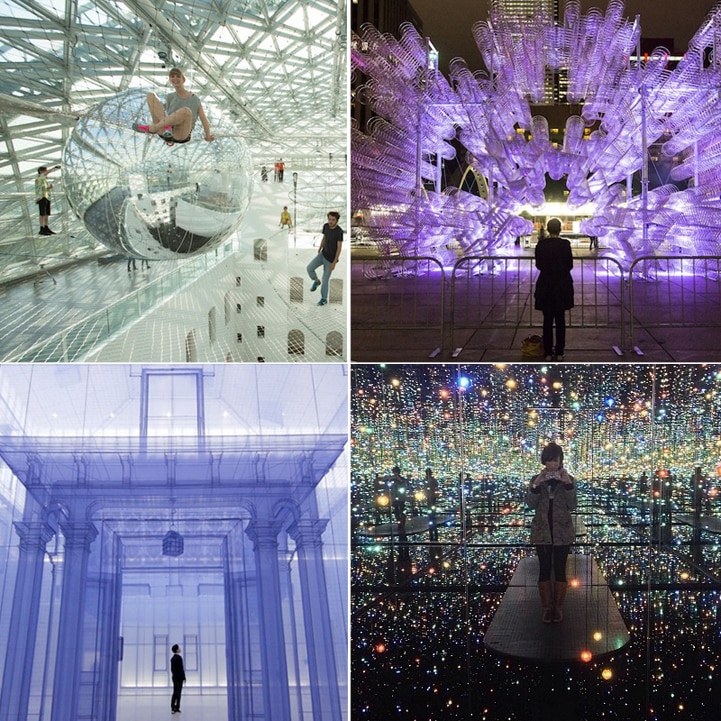
Out of all the different types of art forms we write about on a daily basis, there's one that clearly stands apart from the rest: installation art. According to Merriam-Webster, an installation is defined as “a work of art that usually consists of multiple components often in mixed media and that is exhibited in a usually large space in an arrangement specified by the artist.”
Why do we love installation art? For many reasons. First, it's oftentimes immersive, providing visitors with a multi-sensory experience. Next, it's usually site-specific, meaning that the art installation was built for a particular time and space. Finally, it's highly imaginative, as it brings several different materials together to create something original and unexpected.
Here, we take a look at the most stunning art installations that were exhibited around the world in 2013. If you were lucky enough, you may have experienced one or a few of these artworks first-hand!
Colorful Canopies of Umbrellas by Sextafeira Produes
In July, the city of Agueda, Portugal came alive as colorful canopies of umbrellas appeared above its streets. Production company Sextafeira Produes had created the cheery installation to turn traditional shopping streets into an engaging visual experience.
Photographer Patrcia Almeida took great shots of a similar installation art piece from the year prior, which went viral. This was part of an art festival called AgitÁgueda.
From the Knees of My Nose to the Belly of My Toes by Alex Chinneck
From the Knees of My Nose to the Belly of My Toes is a surreal display by British designer Alex Chinneck that makes it look like the brick façade is sliding right off the front of a building in Margate, England. The eye-catching installation—which took Chinneck approximately one year to bring to fruition—transformed an abandoned, four-story residence by replacing the old frontage with a new one that slumps down and curves outward.
The Fallen by Andy Moss and Jamie Wardley
British artists Andy Moss and Jamie Wardley of Sand In Your Eye produced this incredibly powerful visual display at the D-Day landing beach of Arromanche in France. The two developed this concept, entitled The Fallen, in honor of International Peace Day (September 21), as a reminder of what happens in the absence of that peace.
Unwoven Light by Soo Sunny Park
At the Rice University Art Gallery in Houston, Texas, visitors were immersed in a shimmering world of light, shadow, and color. Called Unwoven Light, this hovering sculpture by artist Soo Sunny Park was made of chainlink fencing and Plexiglas. It invited visitors to enter the space in order to observe how natural and artificial light change when viewed at a certain angle or at different times of the day.
Sirens of the Lambs by Banksy
Leave it to Banksy to mix the cute and the cuddly with the totally disturbing. In the 11th work of his Better Out Than In exhibit that occurred on the streets of New York, the British artist took over a delivery truck and turned it into a slaughterhouse installation. Sixty plush puppets of cows, chickens, pigs, lambs were seen moving their heads through wooden slats.
Home Within Home Within Home Within Home Within Home by Do Ho Suh
In 2013, at the National Museum of Modern and Contemporary Art (MMCA) in Seoul, you could find Do Ho Suh‘s Home Within Home Within Home Within Home Within Home, a 1:1 scale replica of two houses the artist has previously lived in. Created in purple fabric, his traditional Korean home (where he lived in when he was a child) was enveloped and suspended within a more modern building (his first apartment building when he came to the United States in Providence, Rhode Island).
In Orbit by Tomas Saraceno
In Orbit—Argentinian artist Tomas Saraceno‘s largest and most ambitious piece of installation art to date—featured a huge mesh construction suspended above the piazza of the K21 Standehaus museum in Dusseldorf, Germany.
Visitors were able to climb on the gigantic steel wire construction, which spanned three levels and measured 25 meters. The mesh net alone weighed three tons and there were a half a dozen “spheres” or inflated PVC balloons positioned within it.
Forever Bicycles by Ai Weiwei
This year, Chinese artist and activist Ai Weiwei presented a new version of his incredible Forever Bicycles installation in Toronto. As the centerpiece of this year's Scotiabank Nuit Blanche, an all-night contemporary art event that takes over city streets, 3,144 bicycles were stacked 100 feet in length and 30 feet in height and depth in Toronto's Nathan Phillips Square.
Rain Room by Random International
Rain Room, by London and Berlin-based collective Random International, allowed you to experience the rain without getting wet! First shown at Barbican Centre from October 2012 to this March, it came to New York, housed in a temporary gallery next door to the MoMA museum. This was the monumental installation's US debut.
Infinity Mirrored Room – The Souls of Millions of Light Years Away by Yayoi Kusama
In Yayoi Kusama‘s Infinity Mirrored Room – The Souls of Millions of Light Years Away, hundreds of multicolored LED lights, suspended at different heights and dangling from floor to ceiling, transformed a room into what feels like eternity.
The cube-shaped, mirror-paneled room had a shallow reflecting pool as its floor, and the lights flickered on and off in a strobe-like effect. Though similar to those Yayoi Kusama has shown previously, like Infinity Mirror Room at the Tate Modern and Fireflies on the Water at the Whitney Museum of Art, this one was made especially for the exhibition at David Zwirner gallery and still promised the viewer a wonderfully surreal experience.
This article has been edited and updated.
Related Articles:
10 Avant-Garde Artists Whose Rainbow Art Installations Will Mesmerize You
30+ Large-Scale Art Installations You Won’t Believe Are Made Entirely of Paper
Street Artist Phlegm Unveils Painted Sculptural Installation at London’s Royal Opera House
